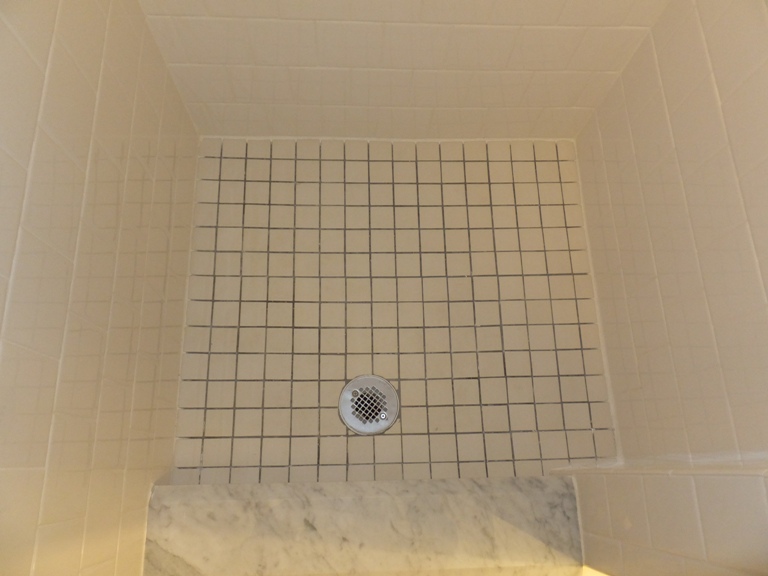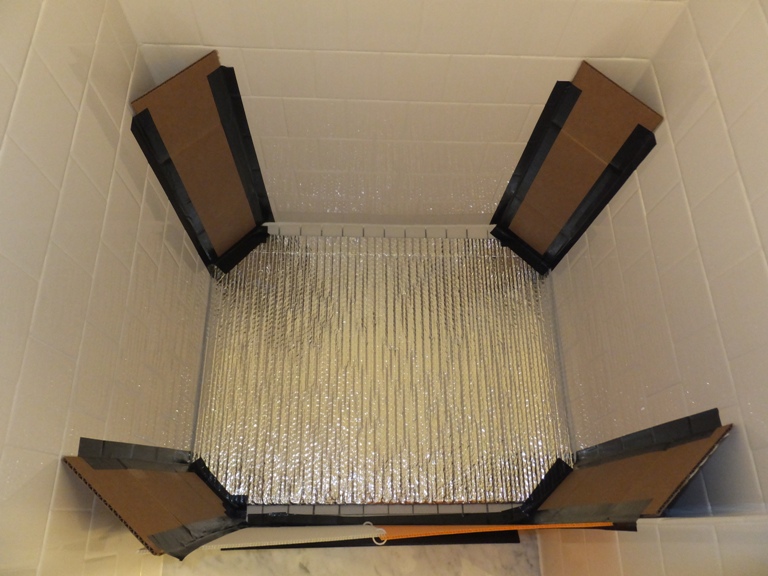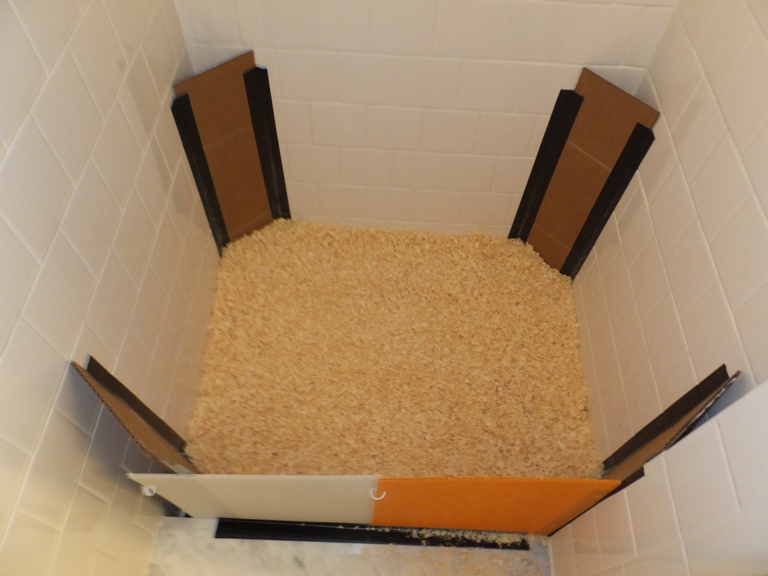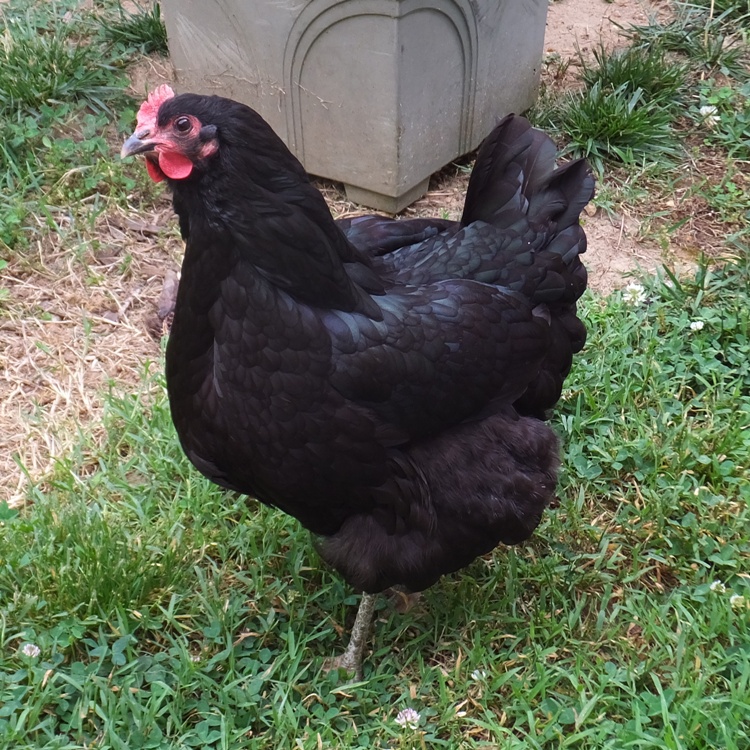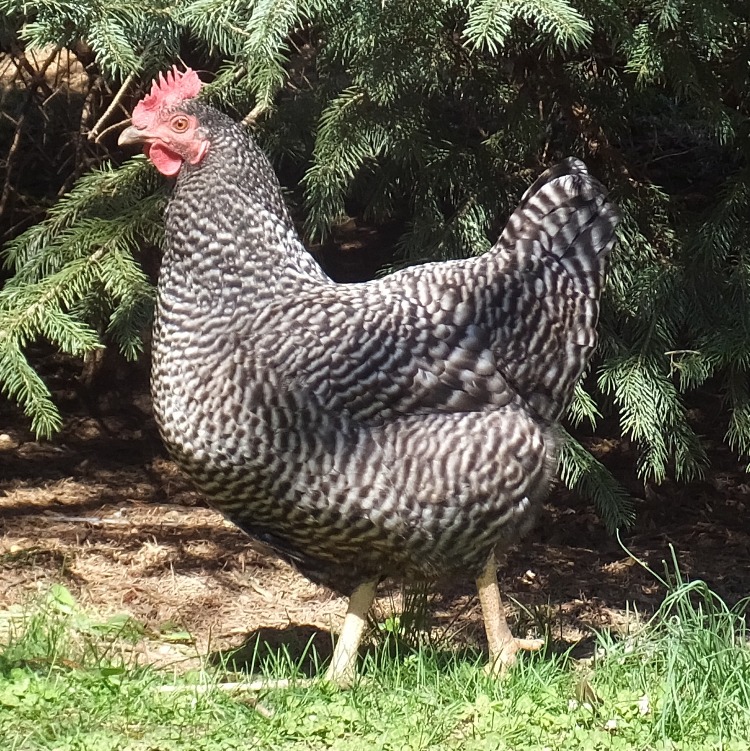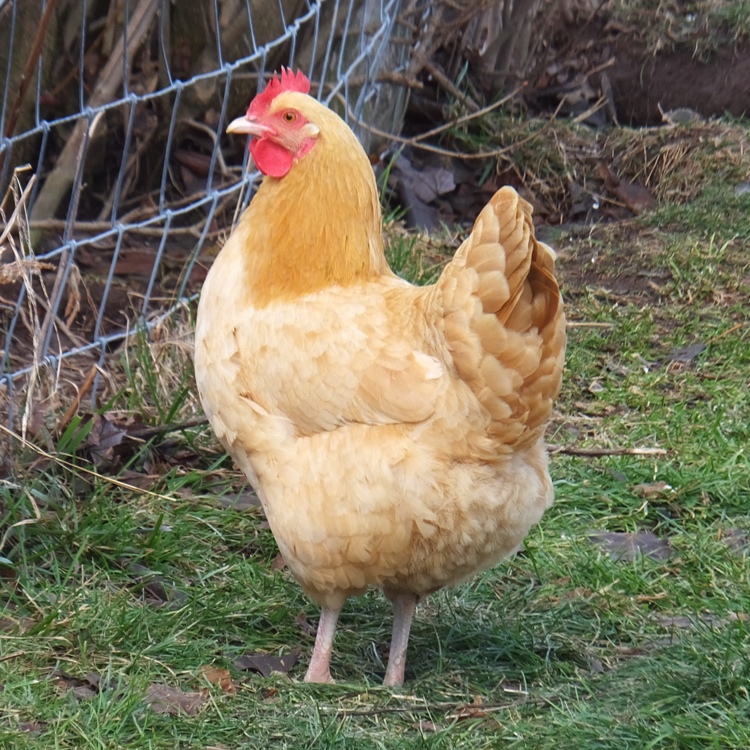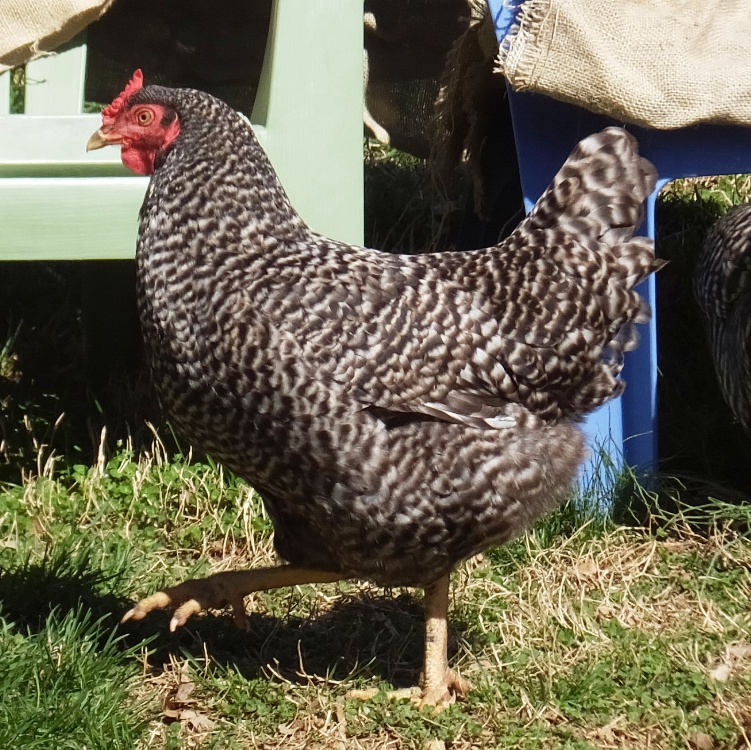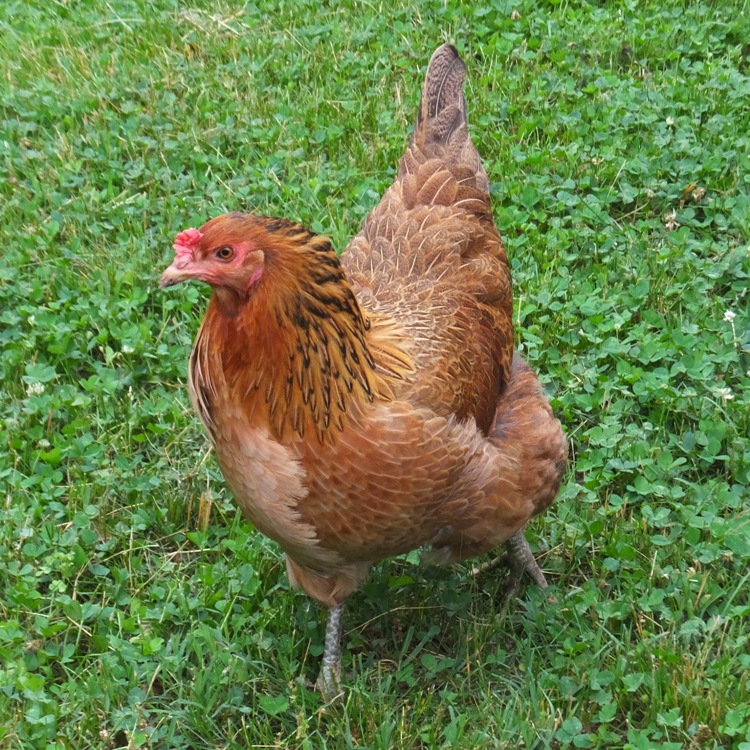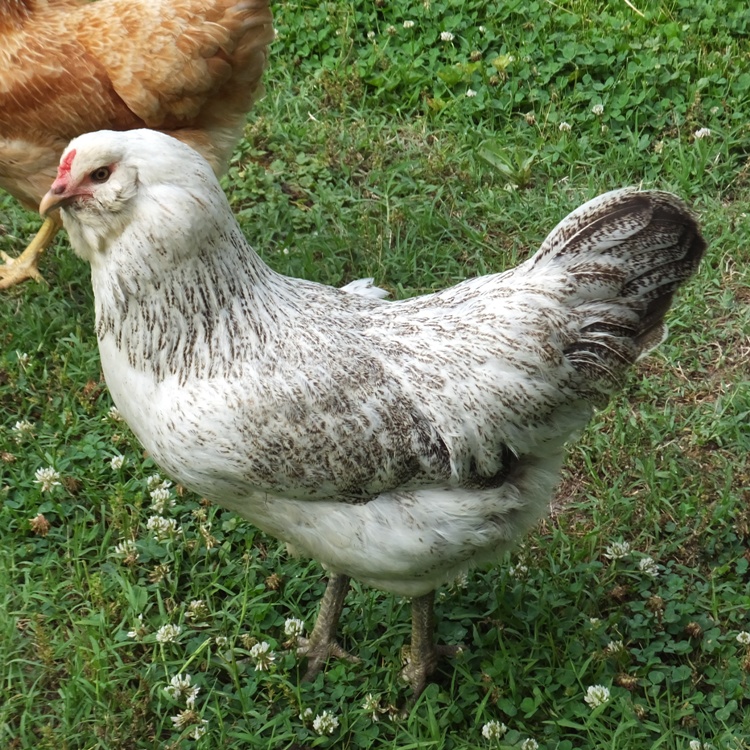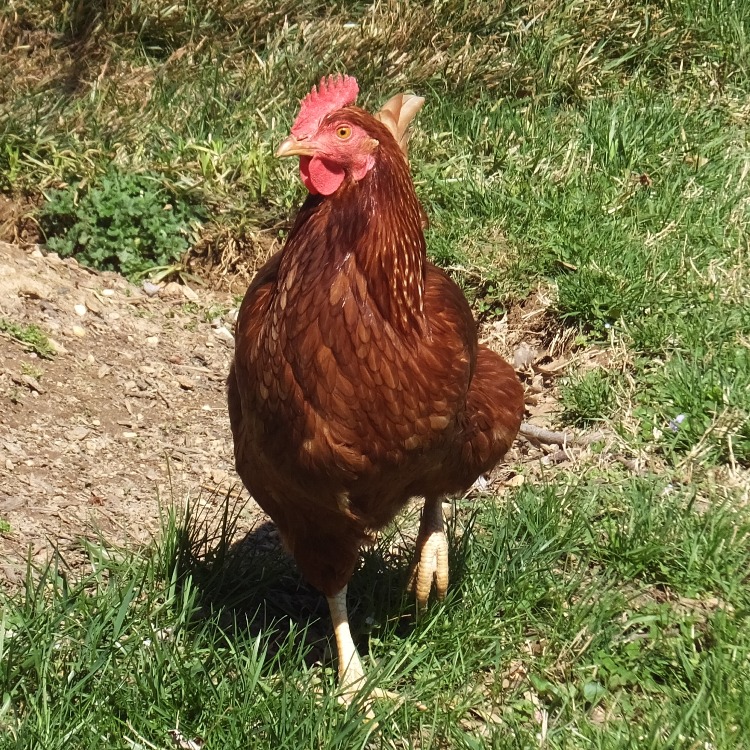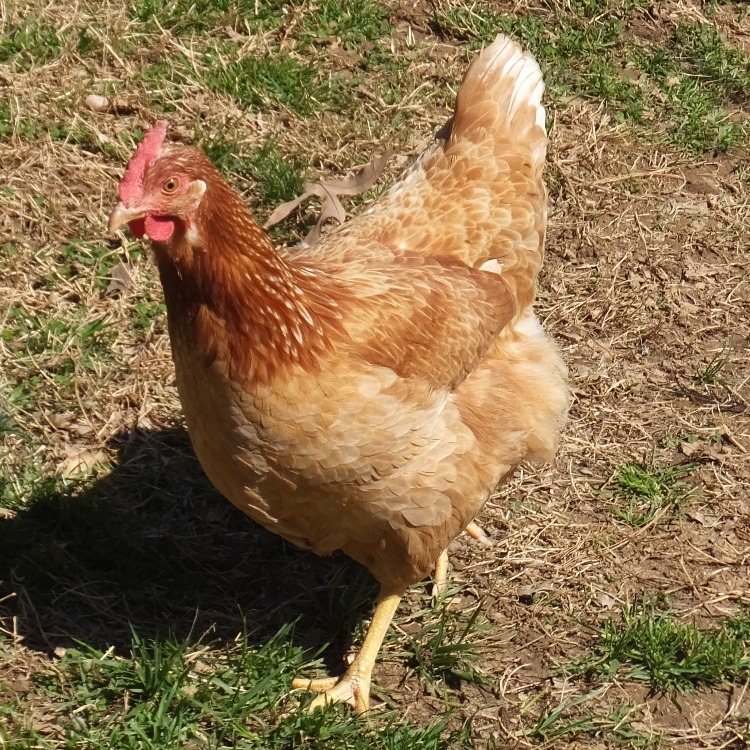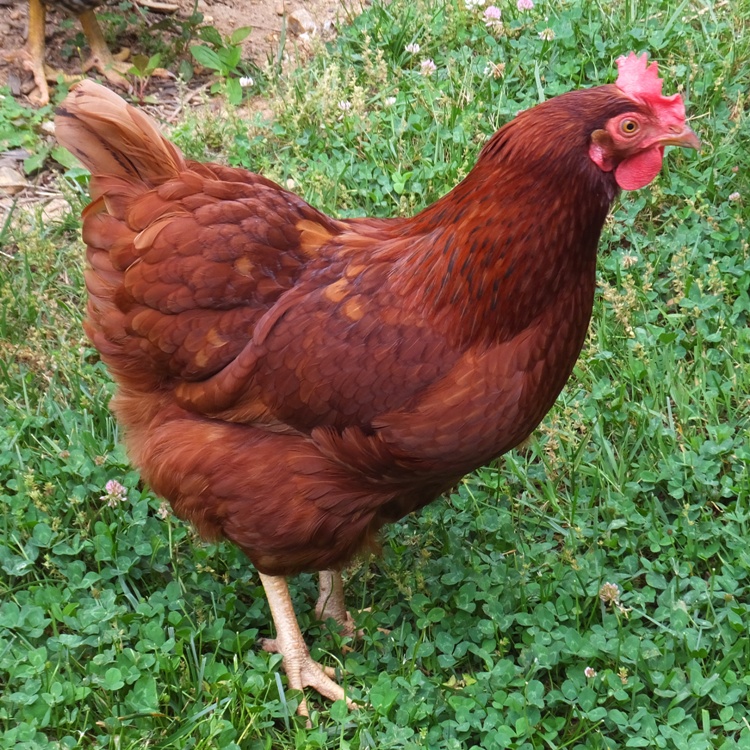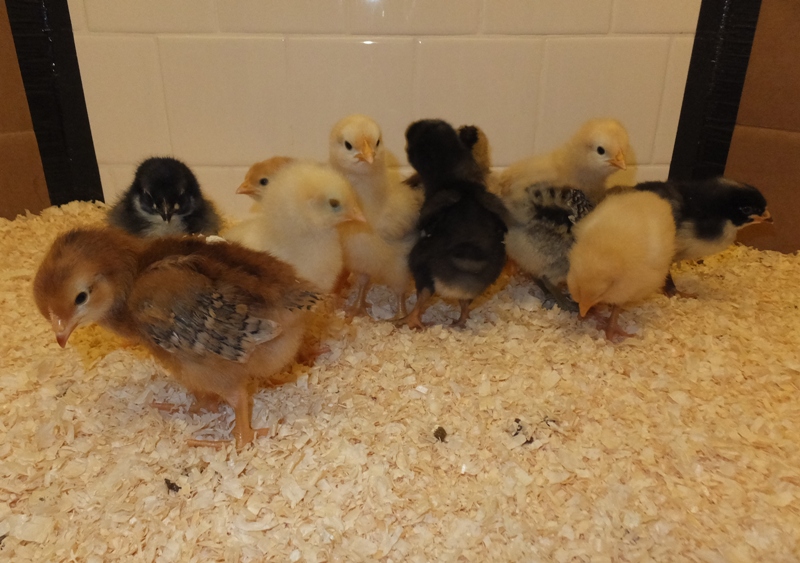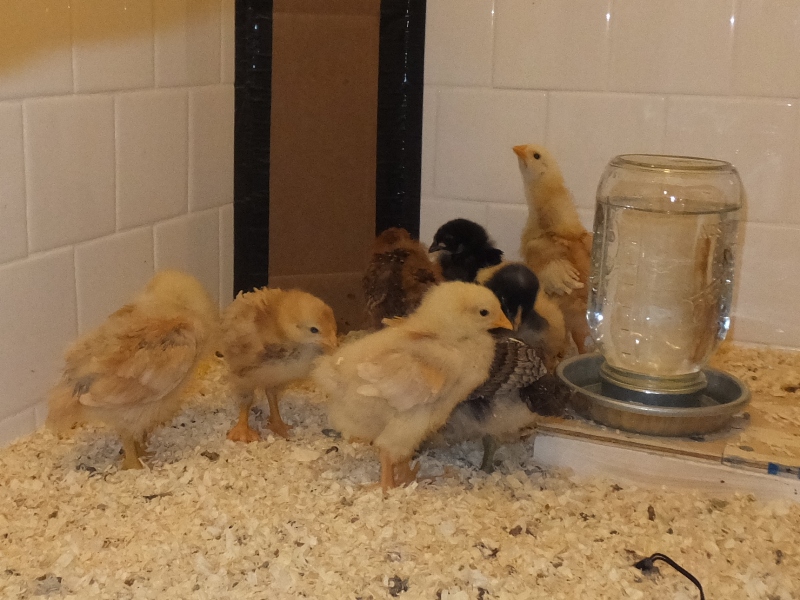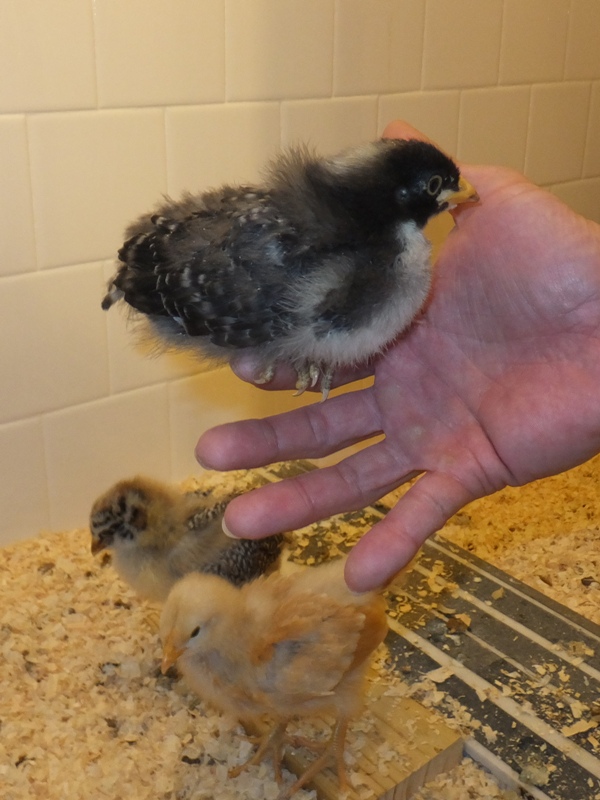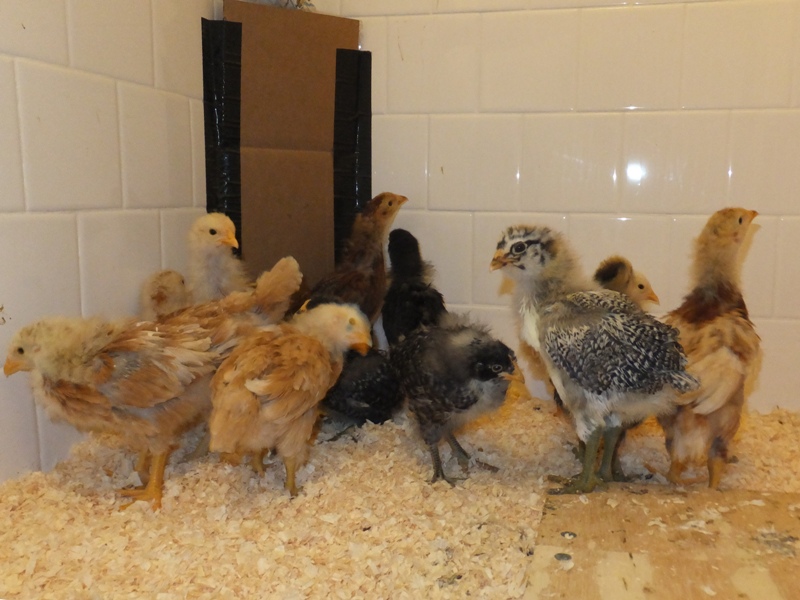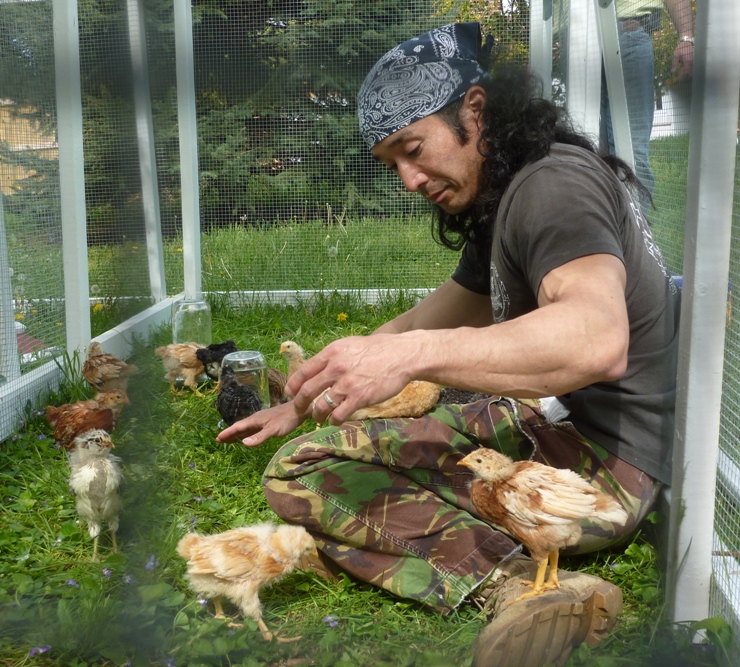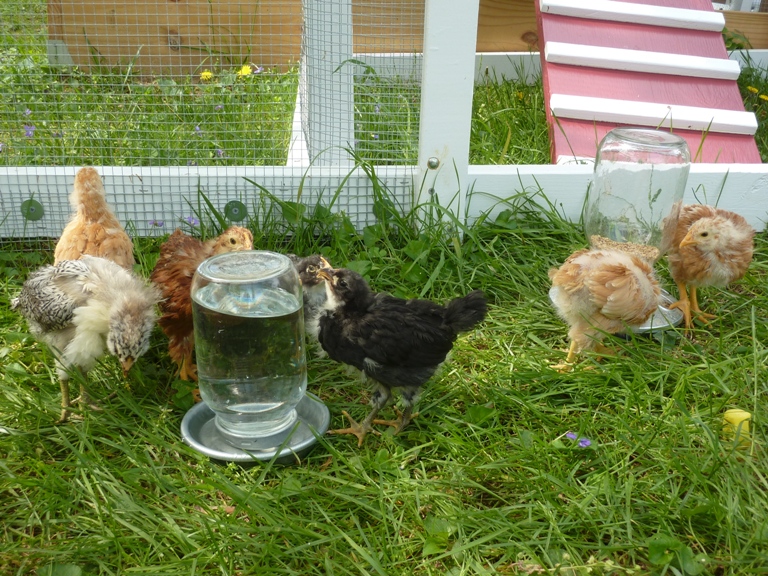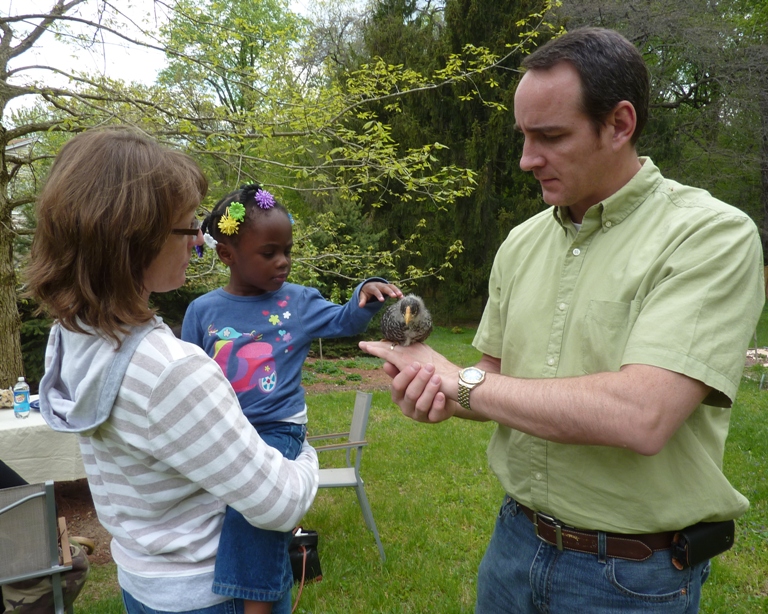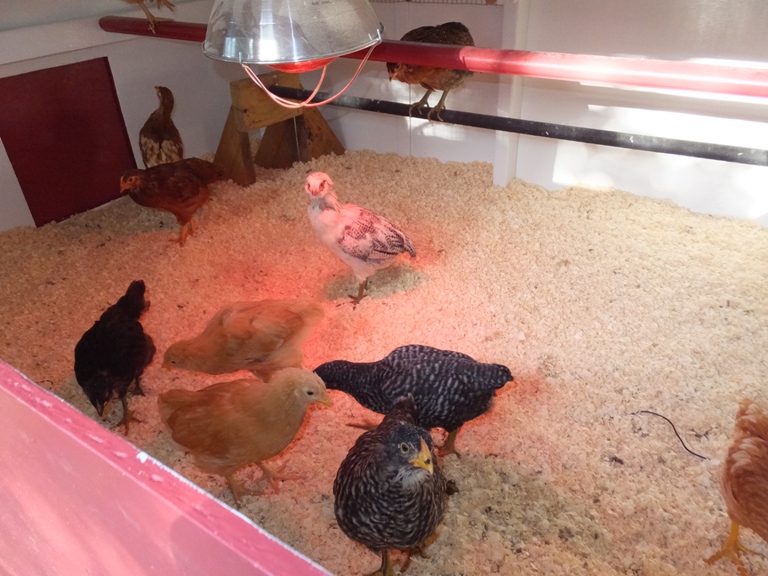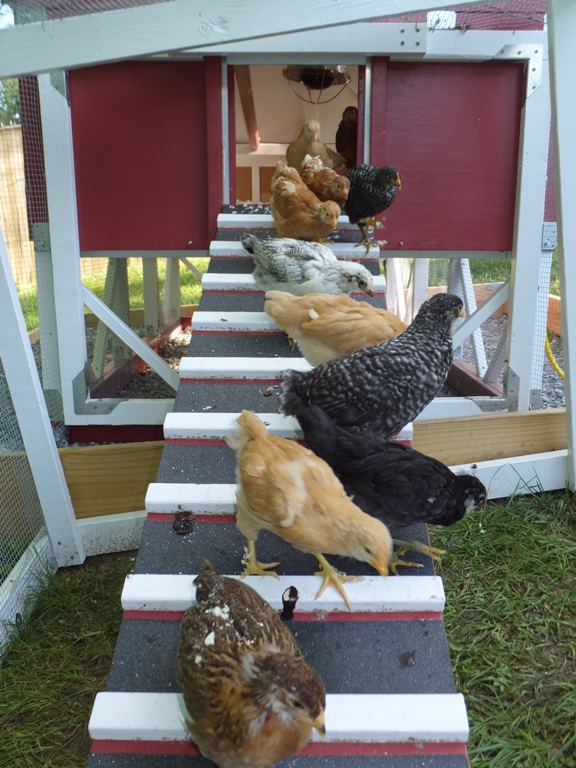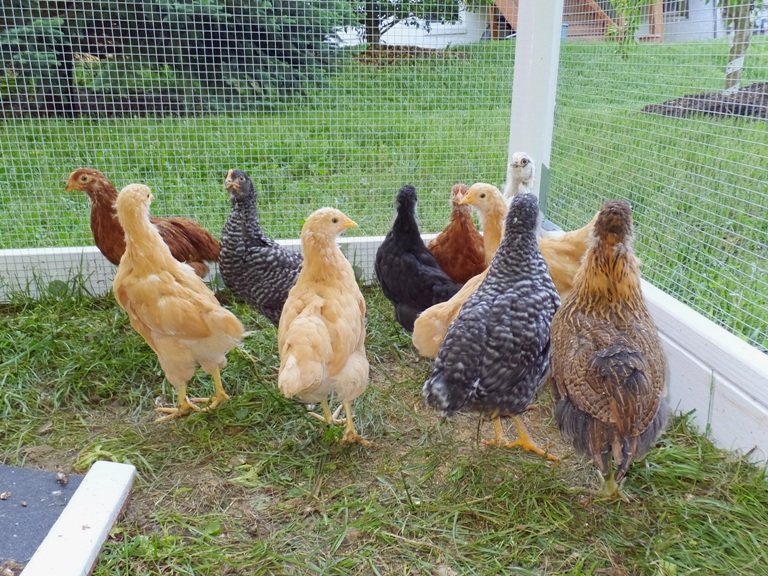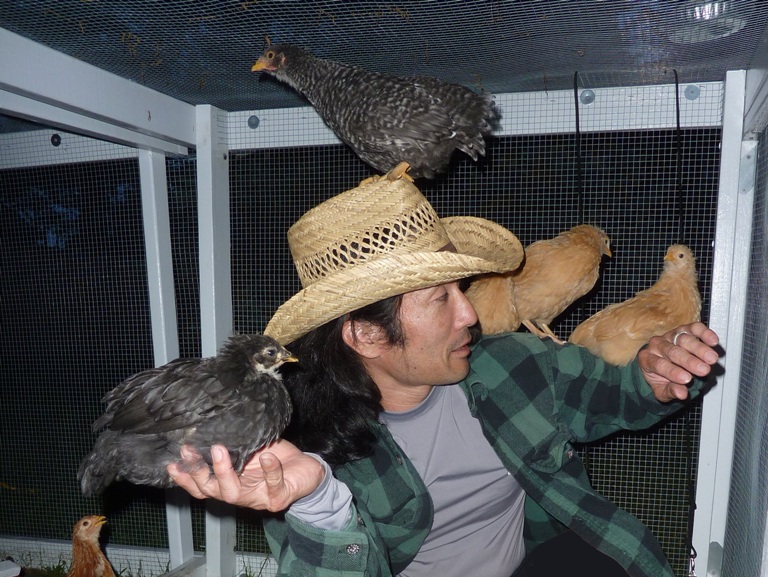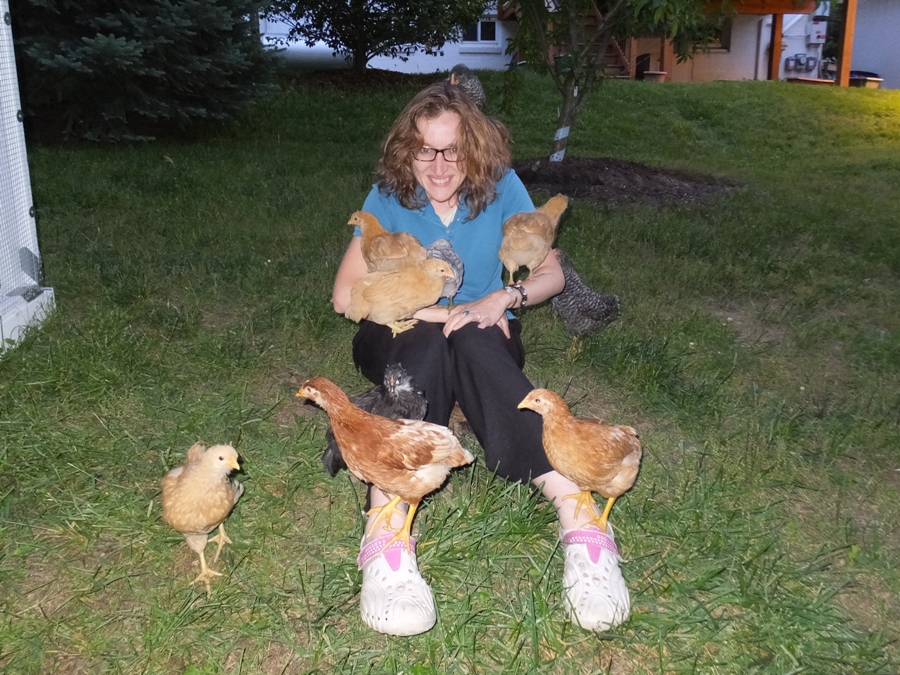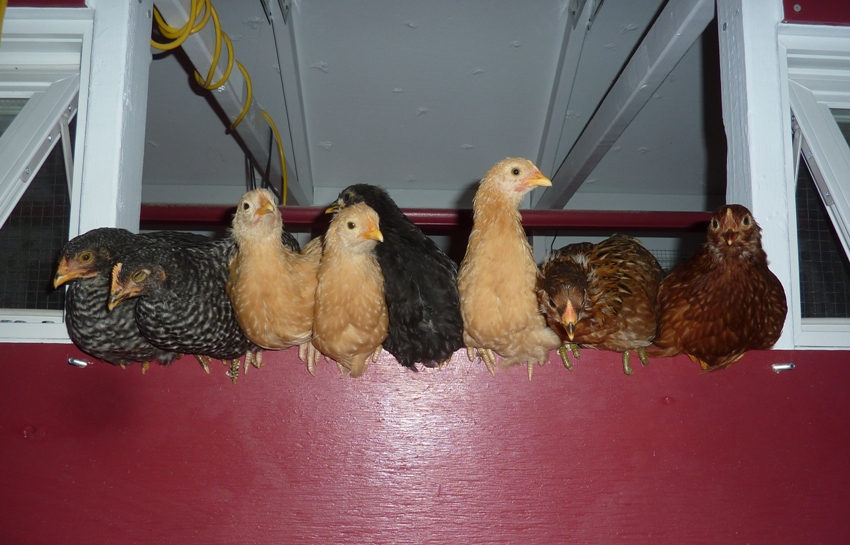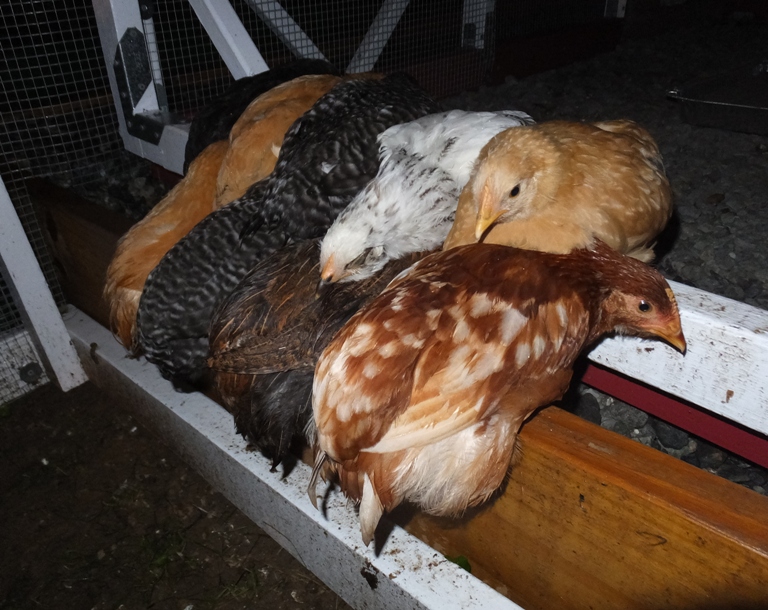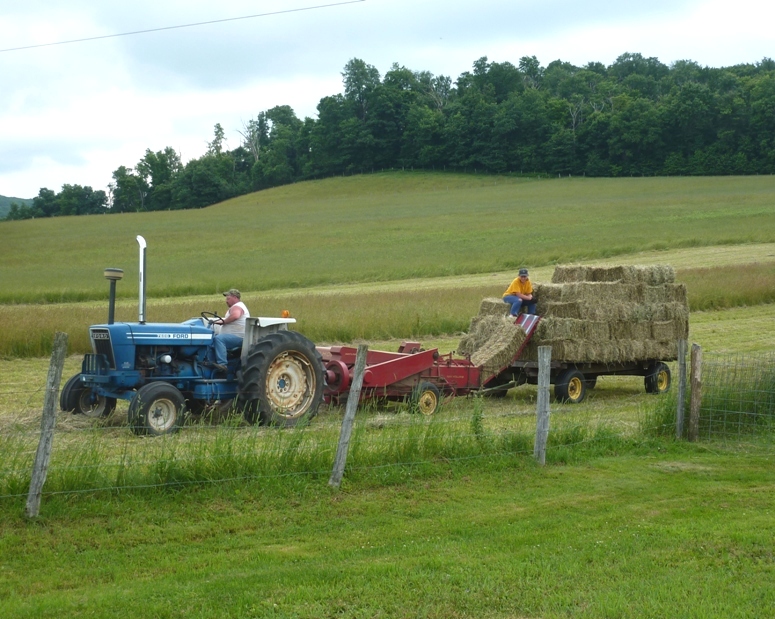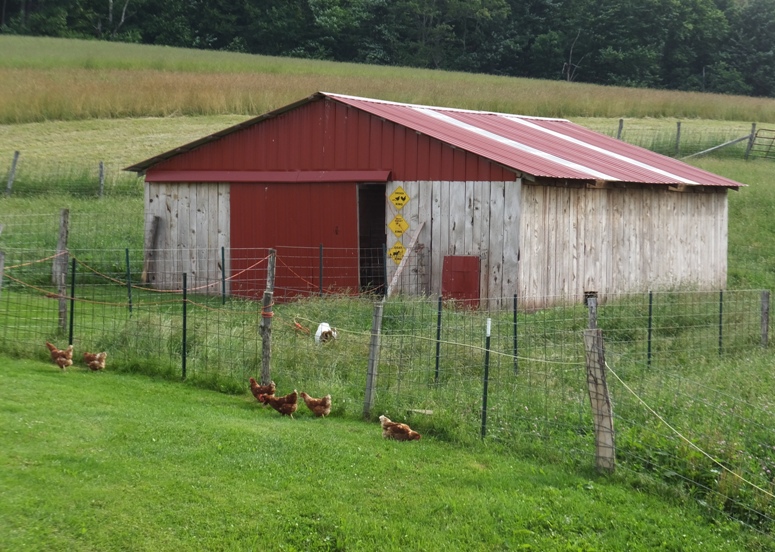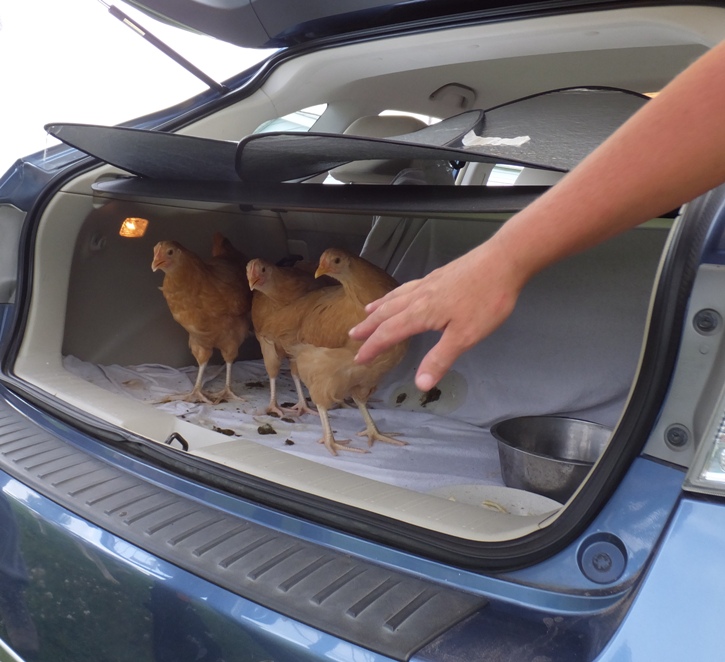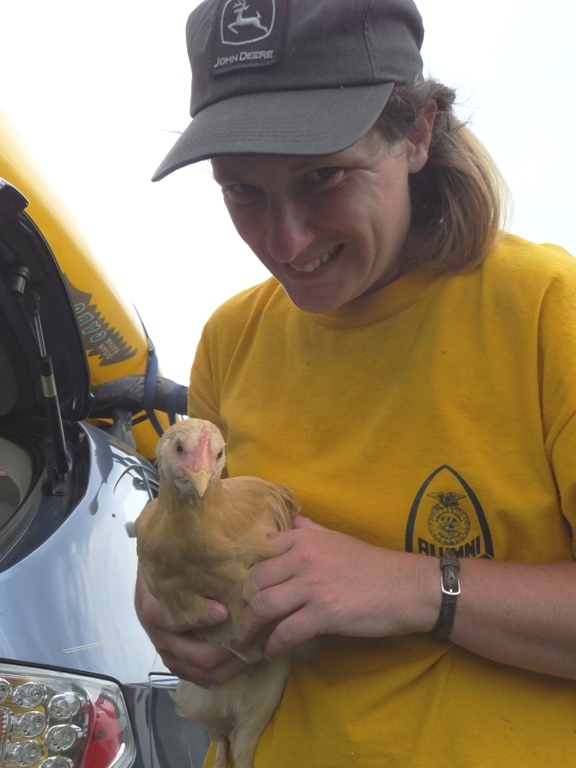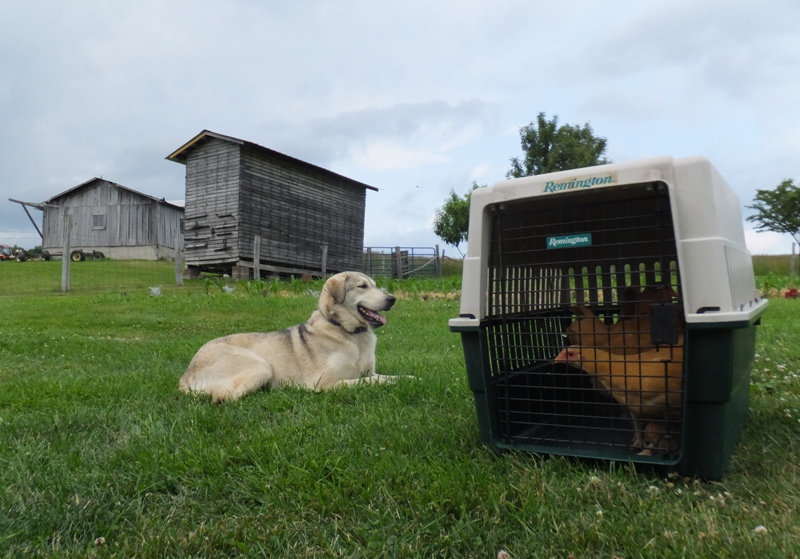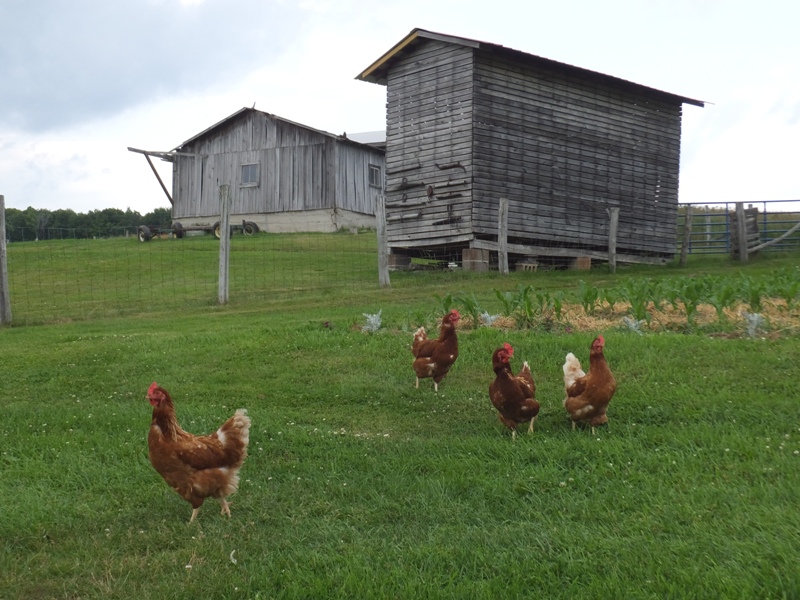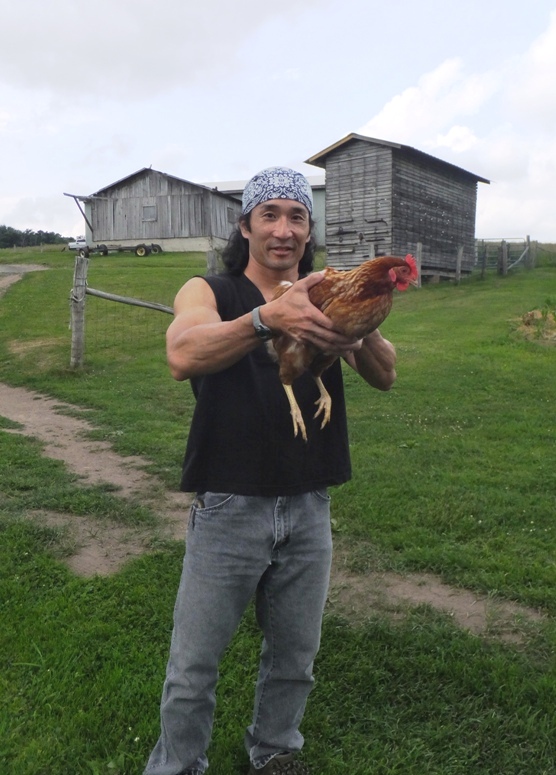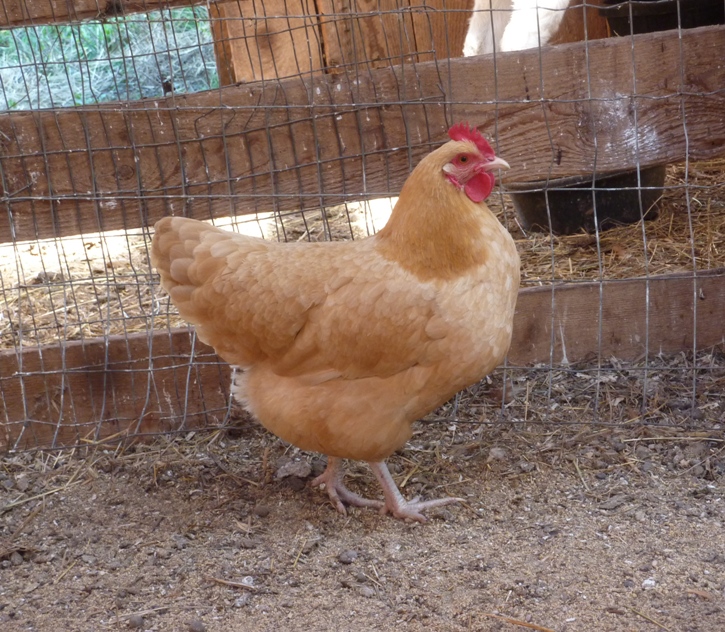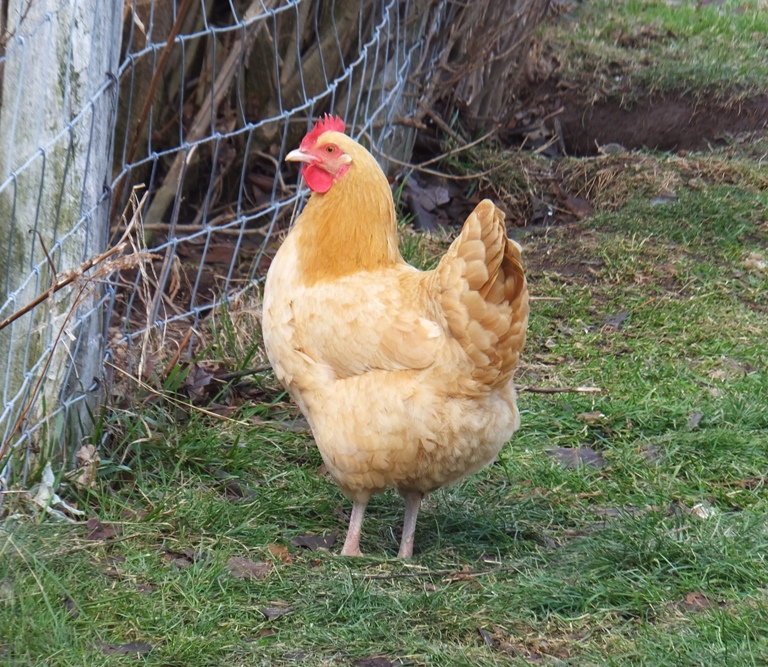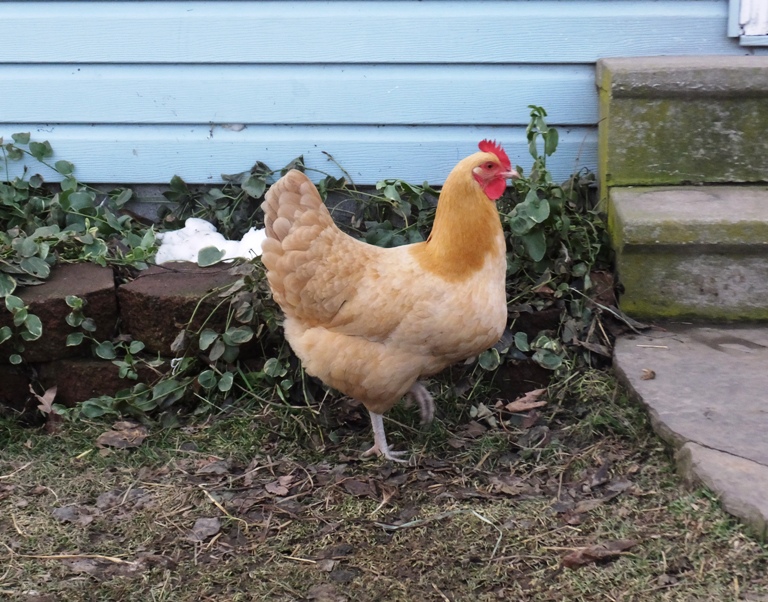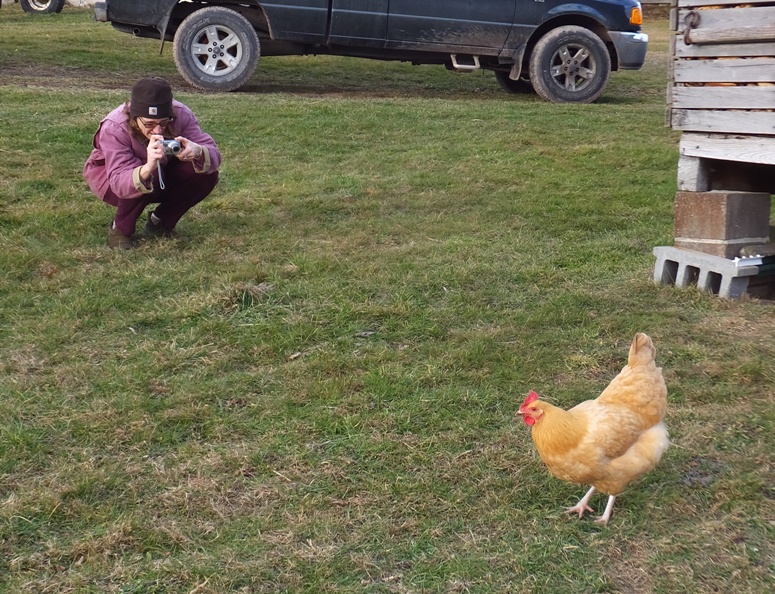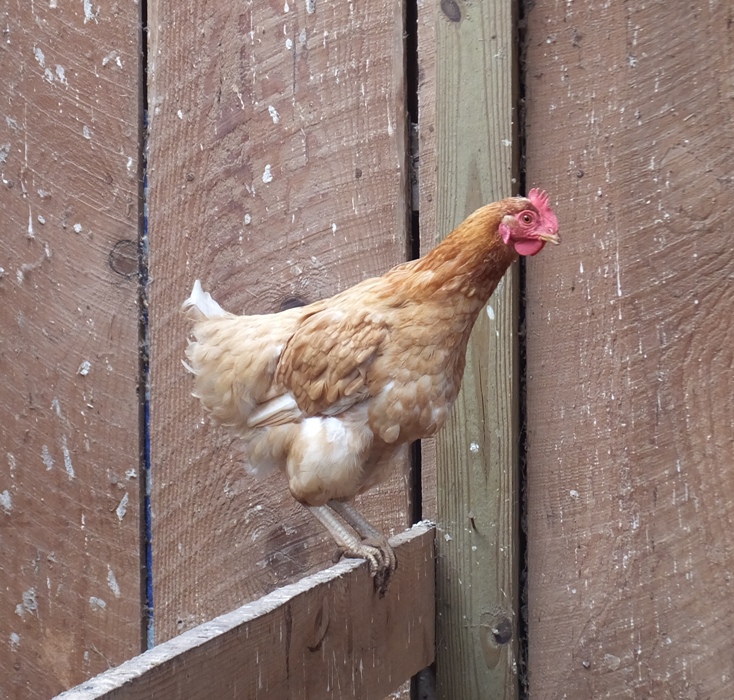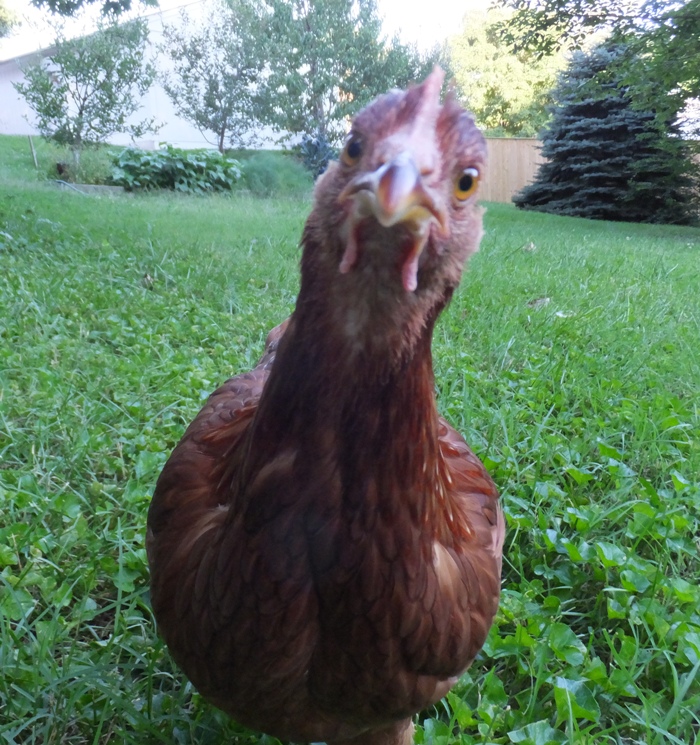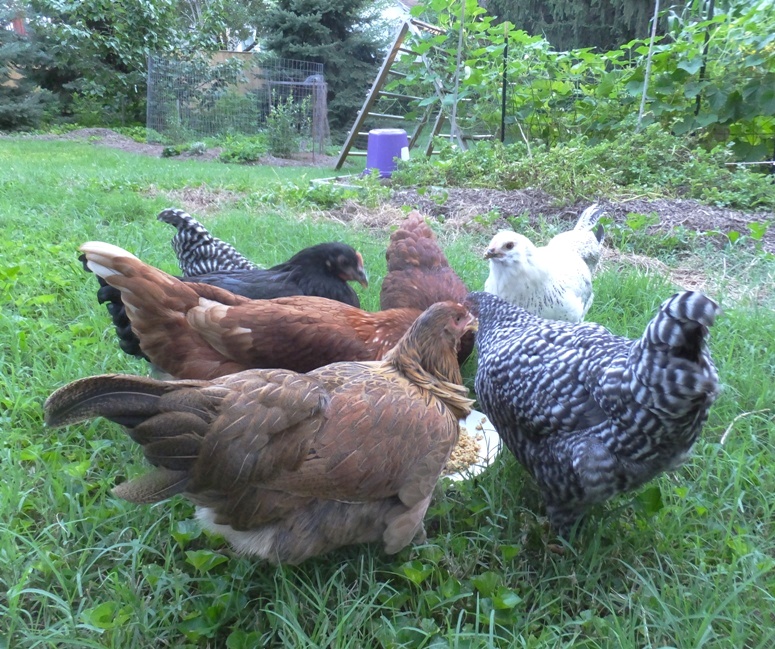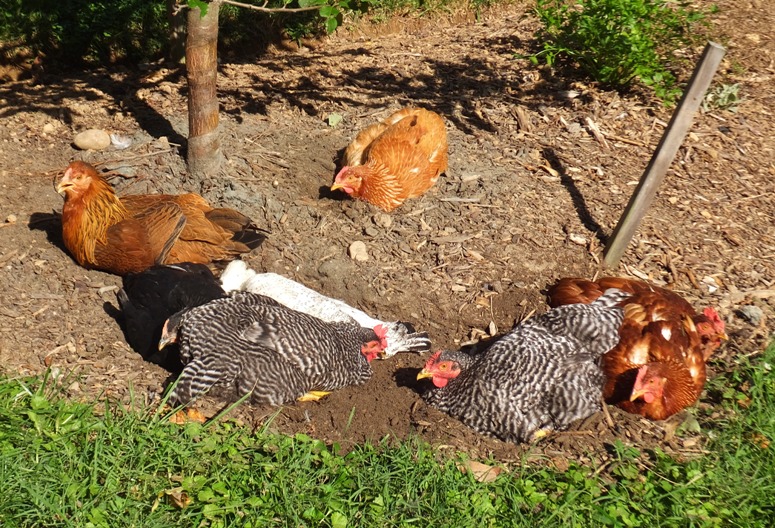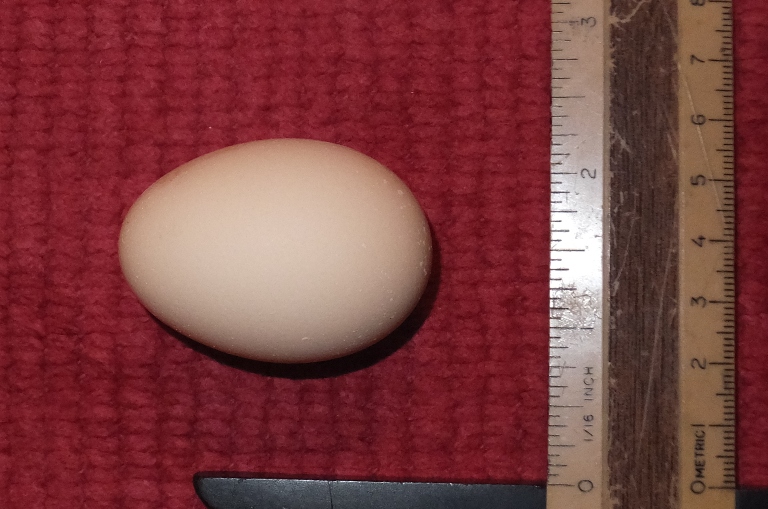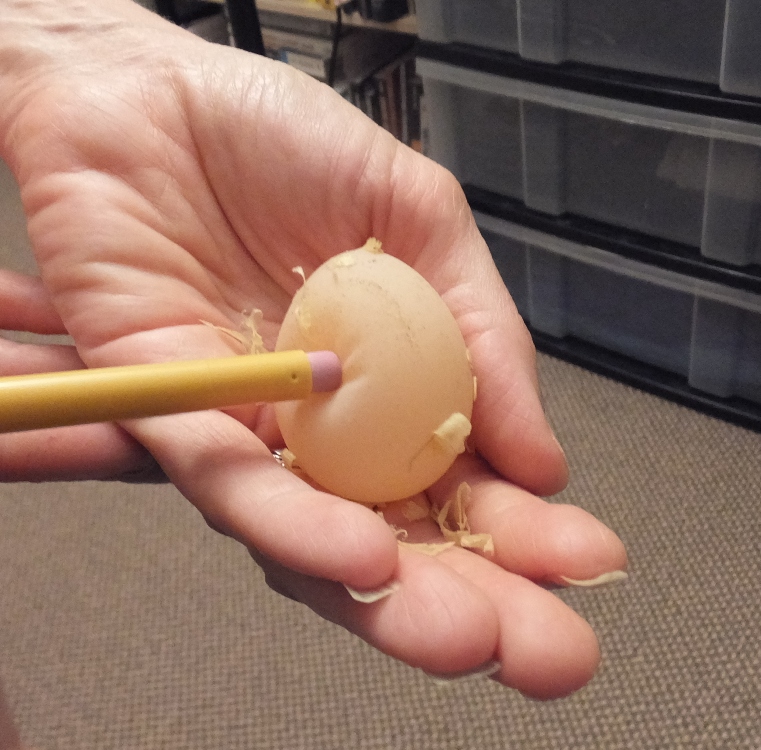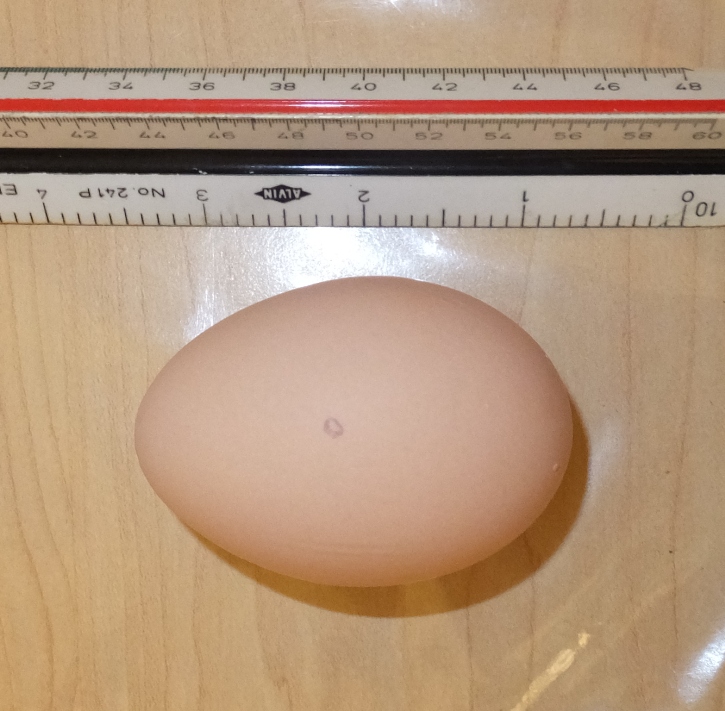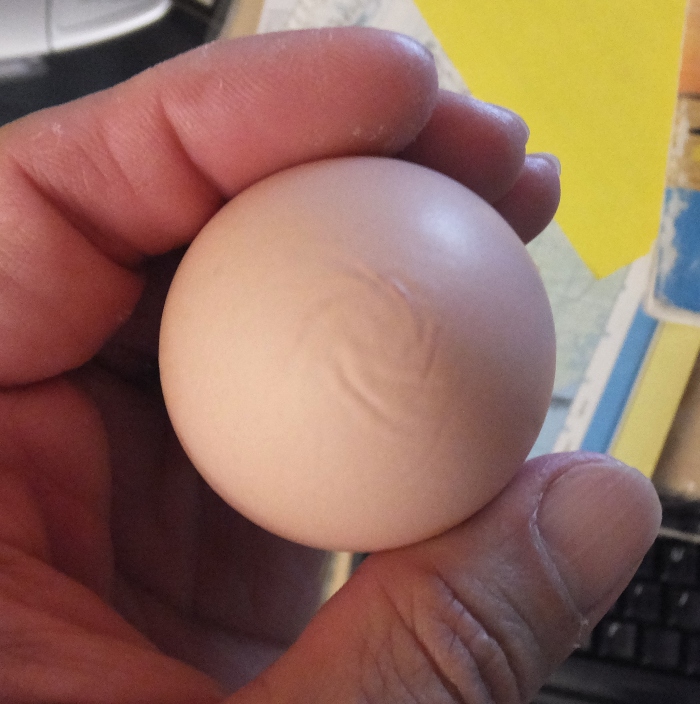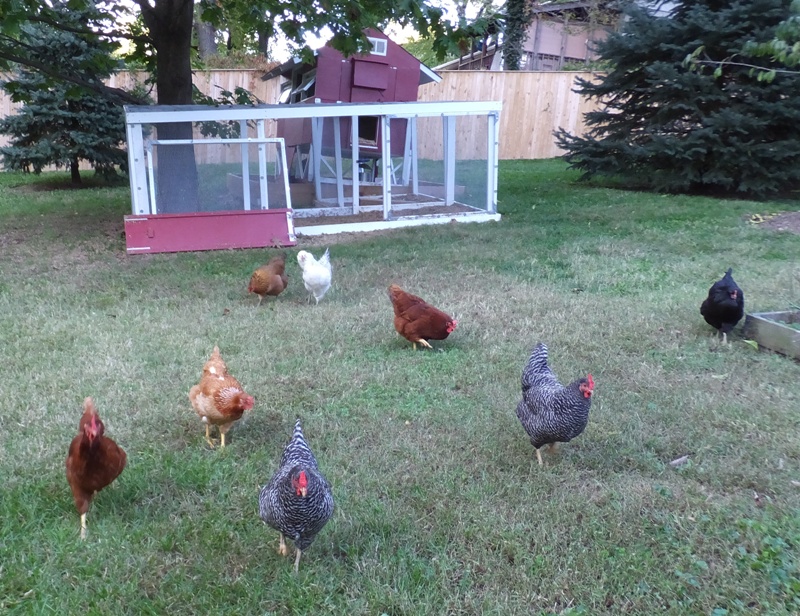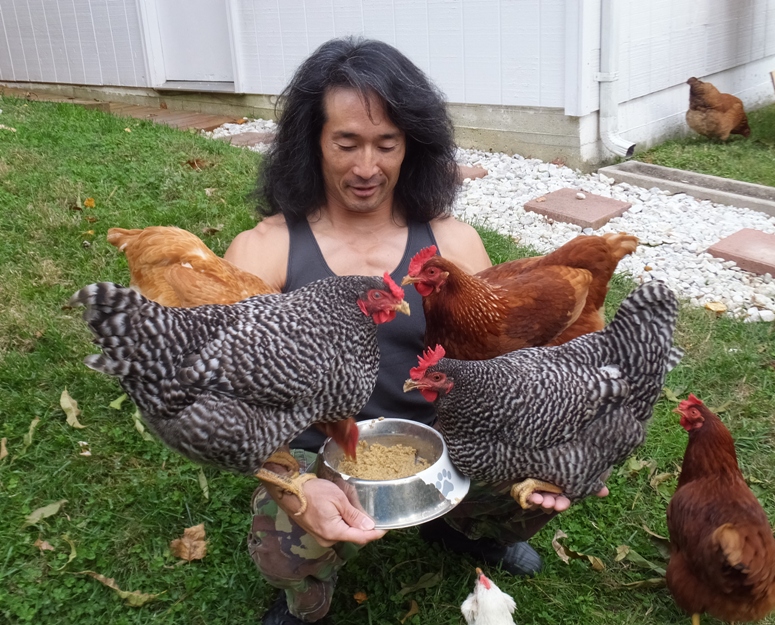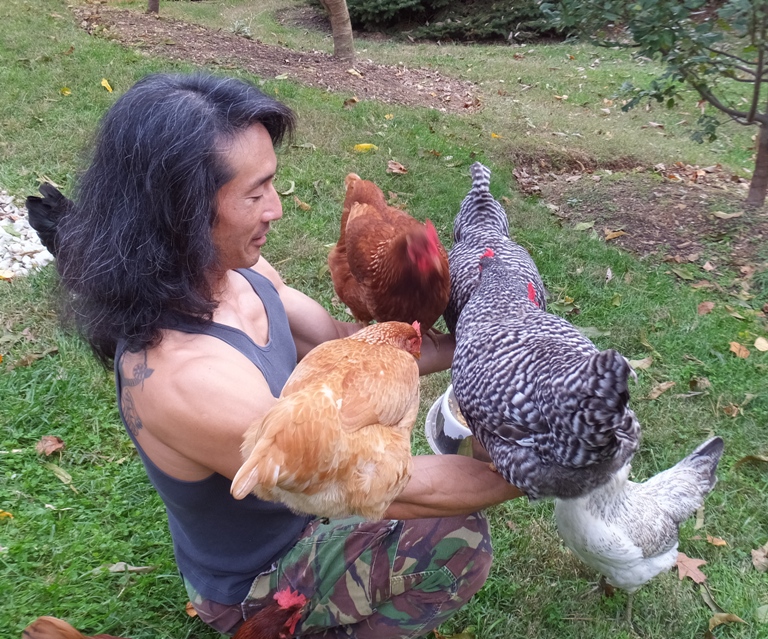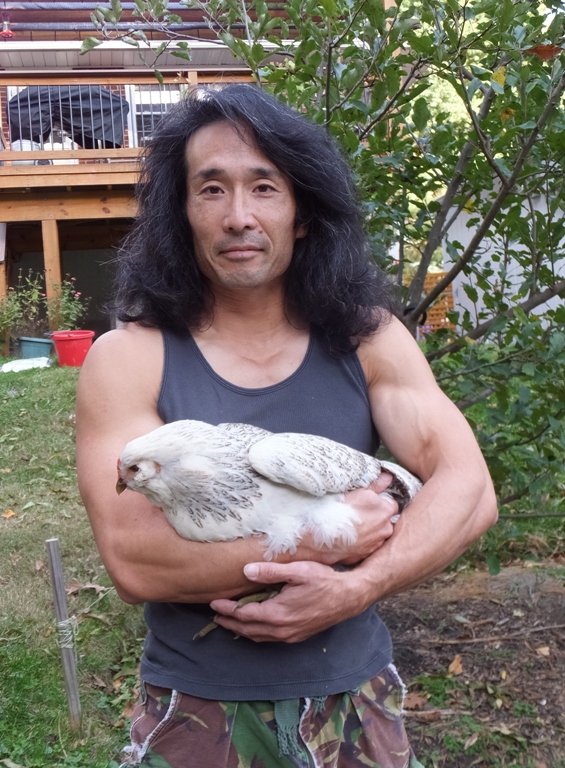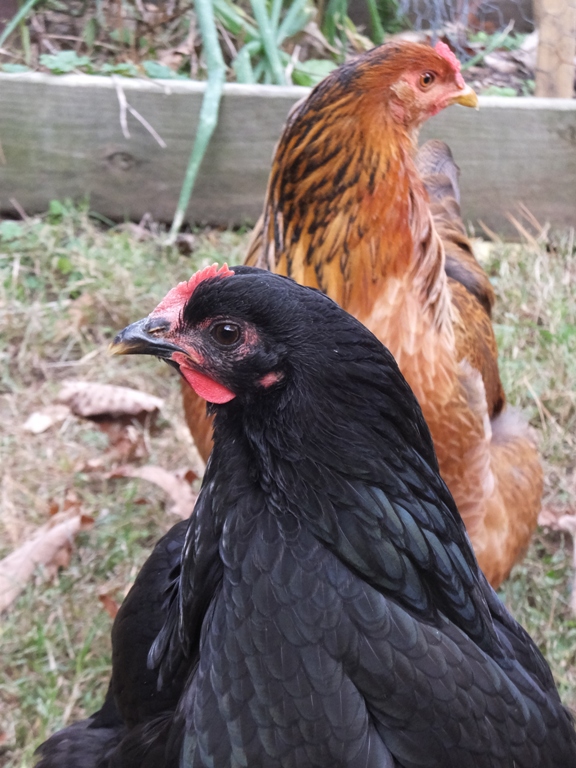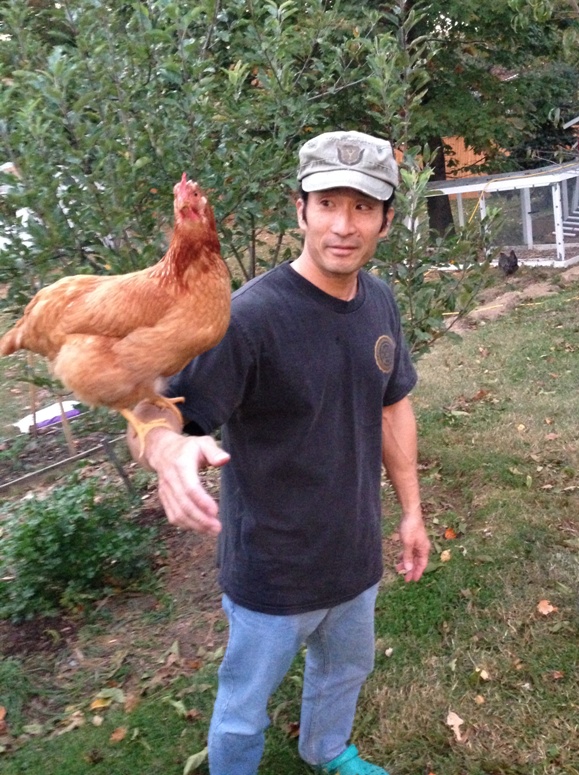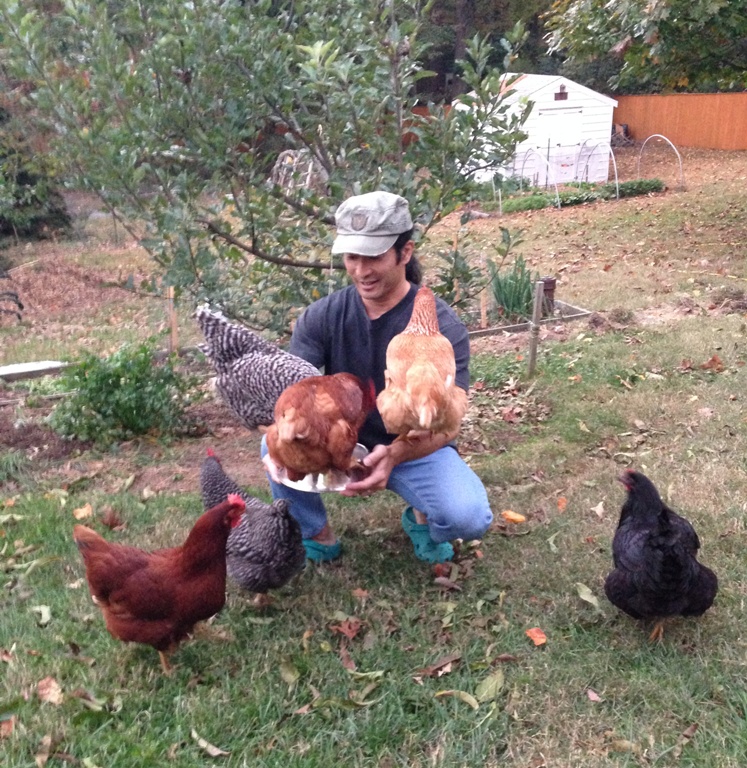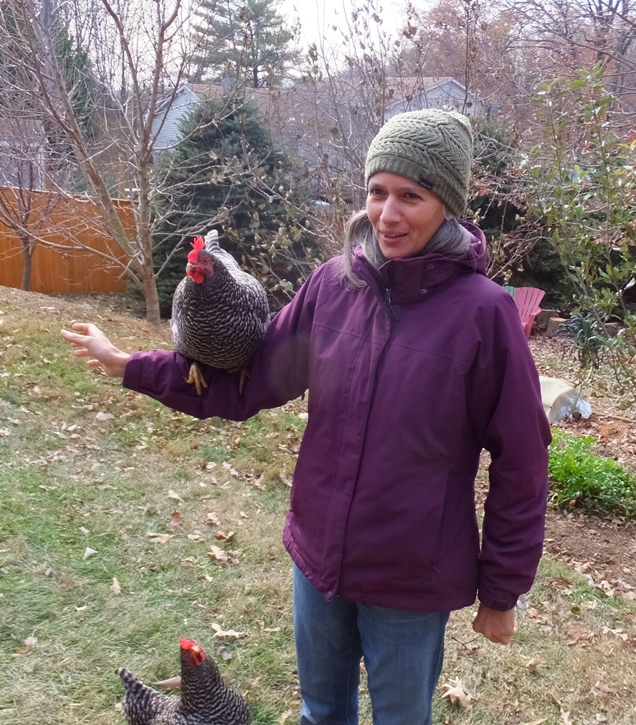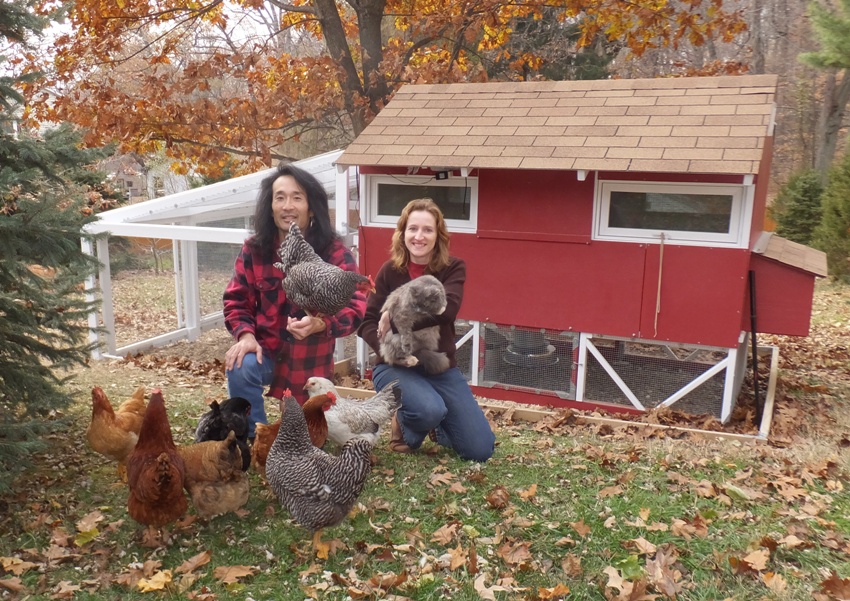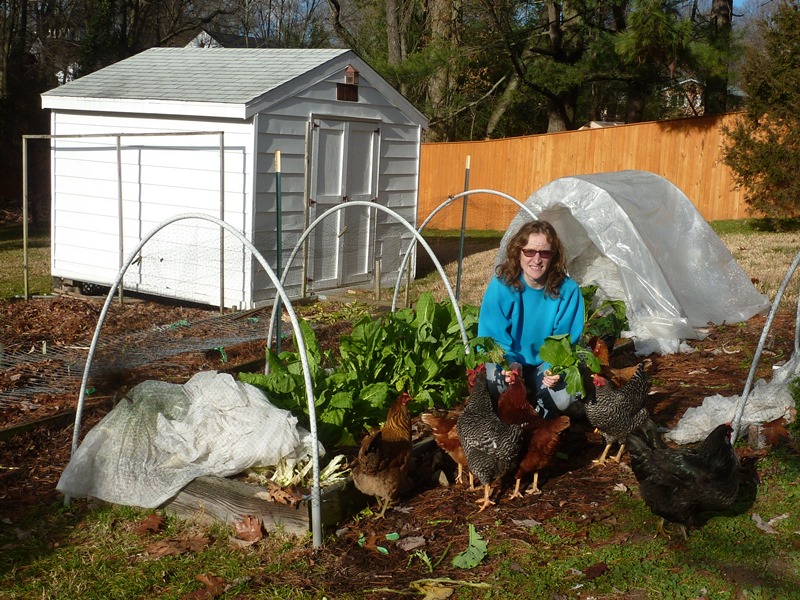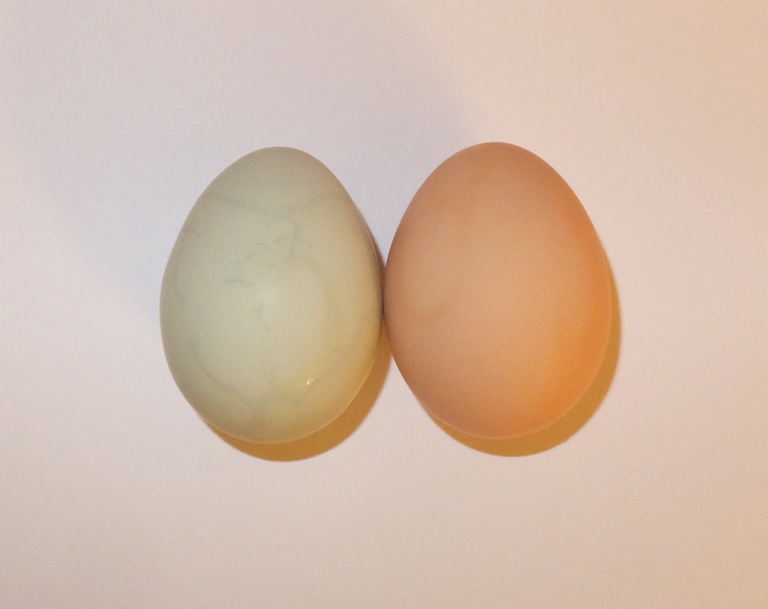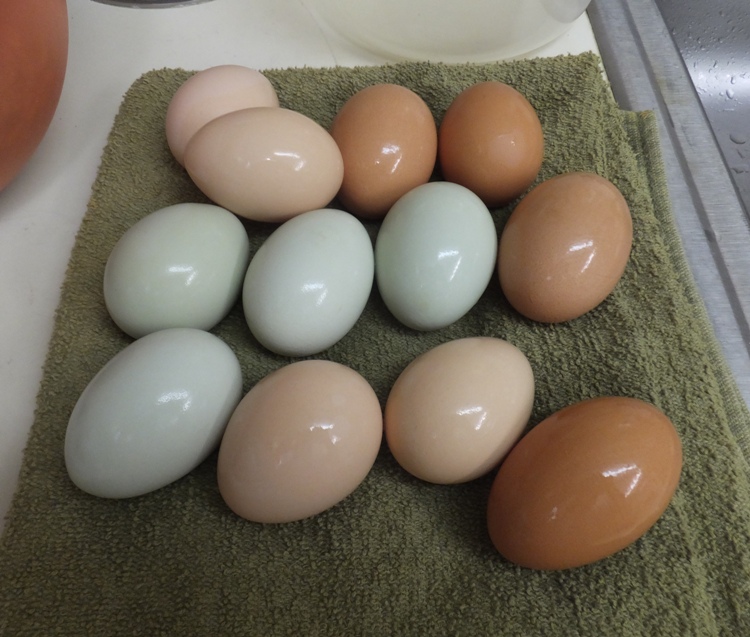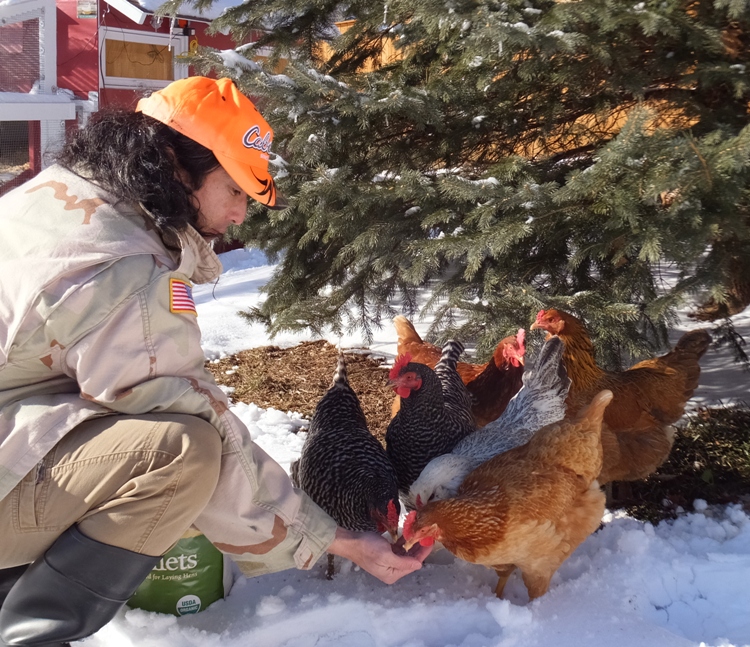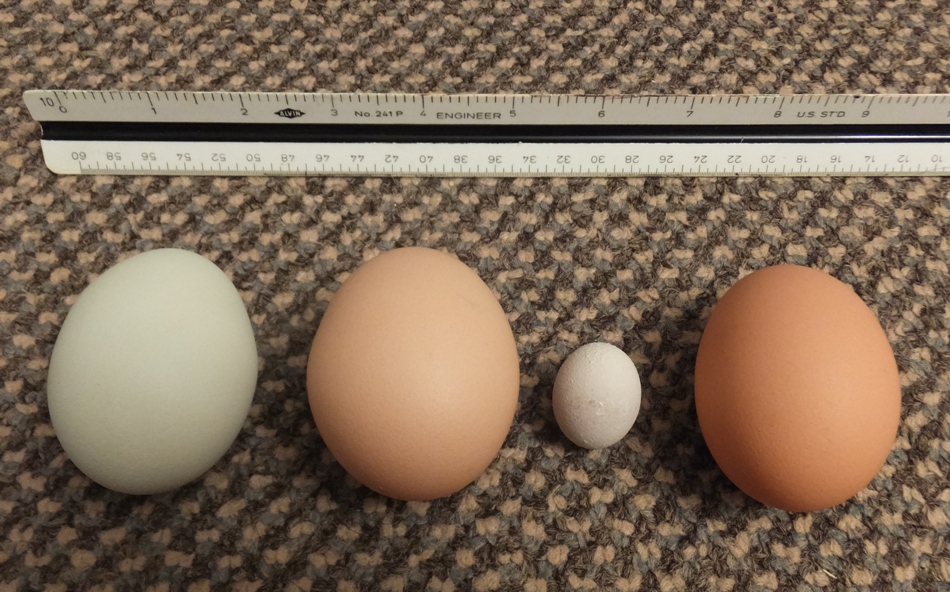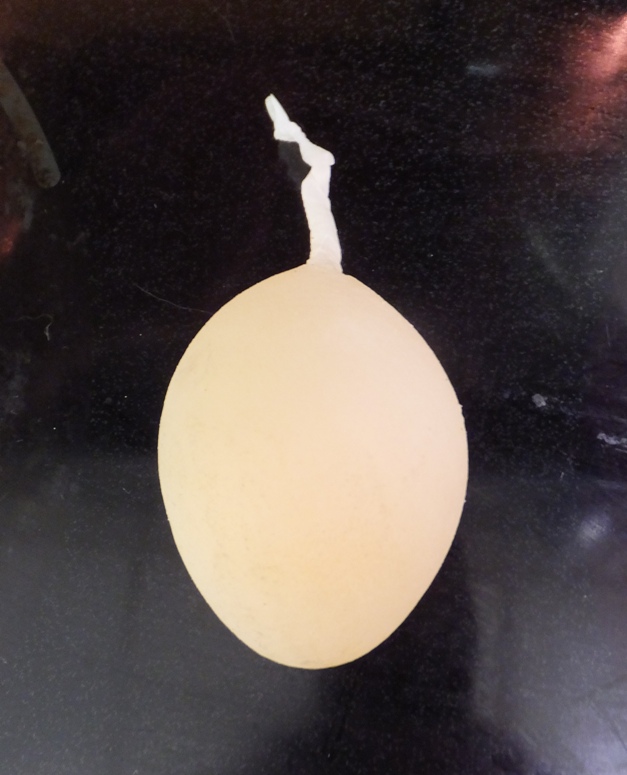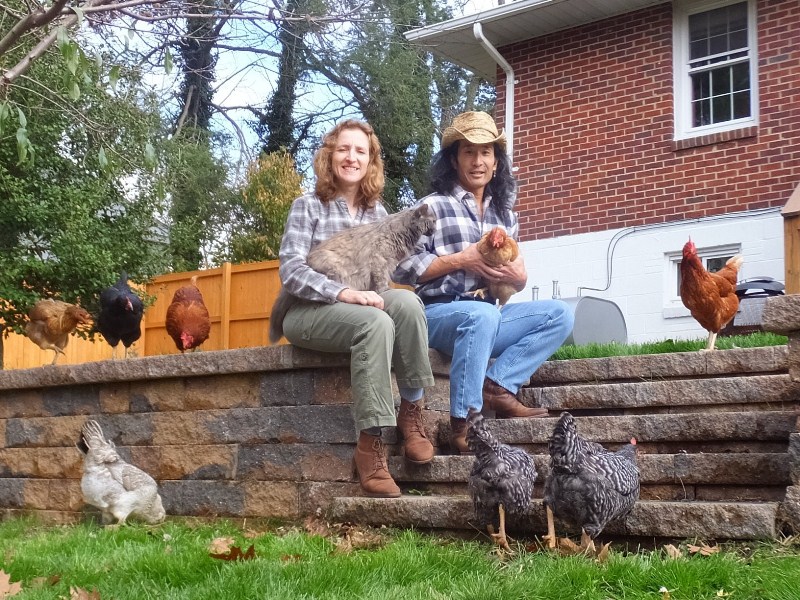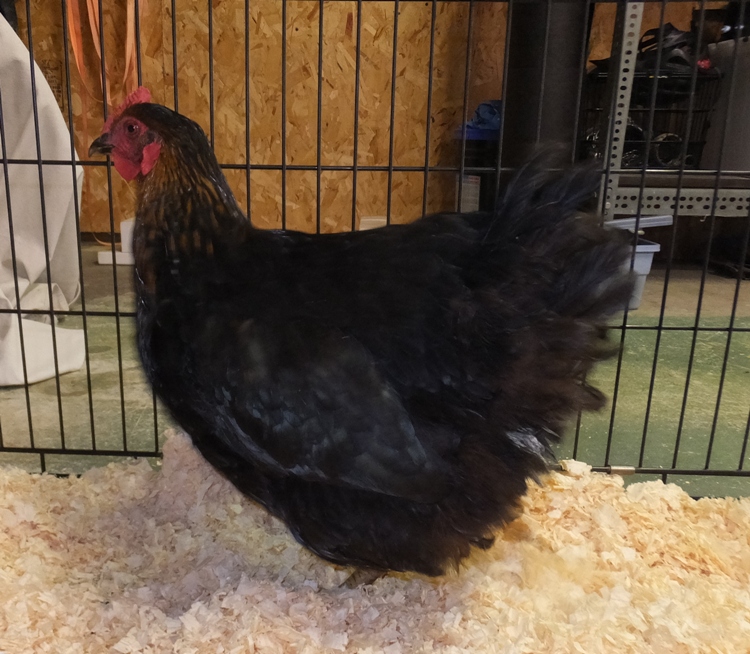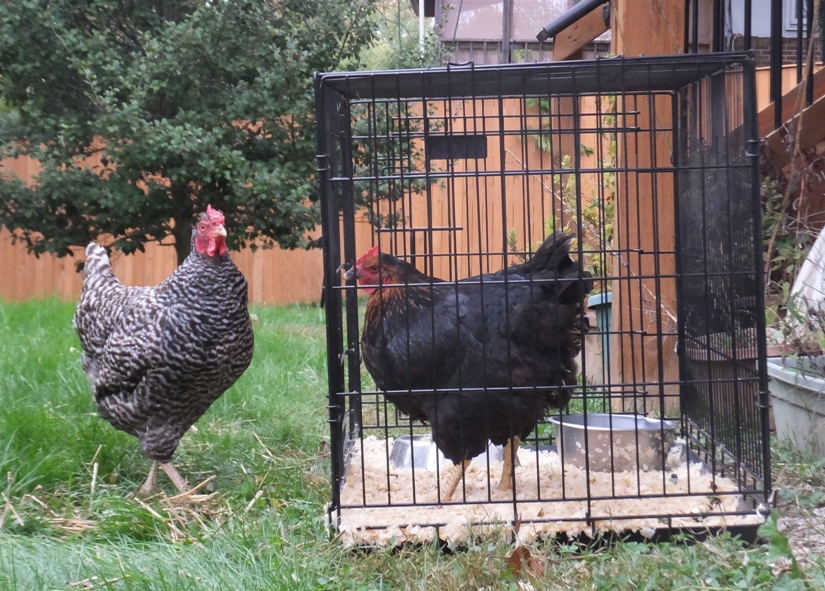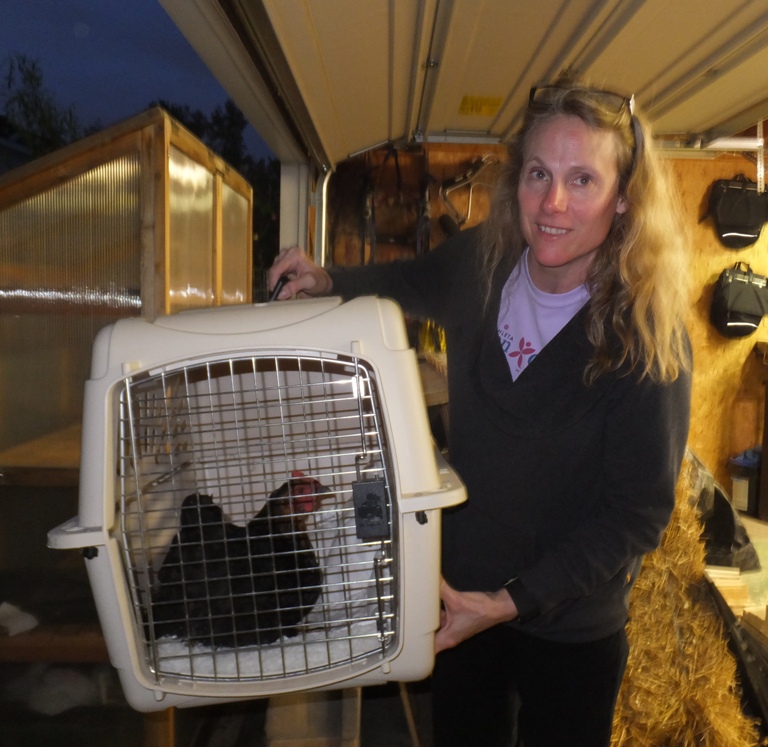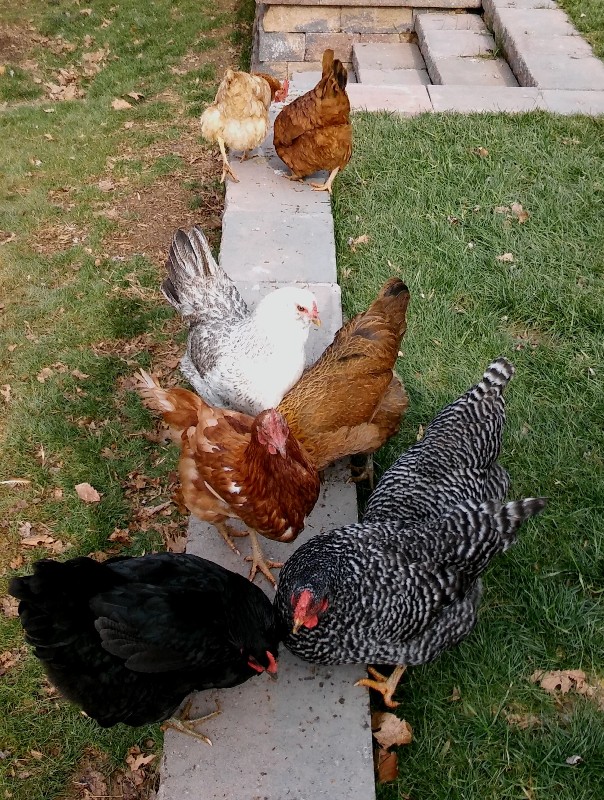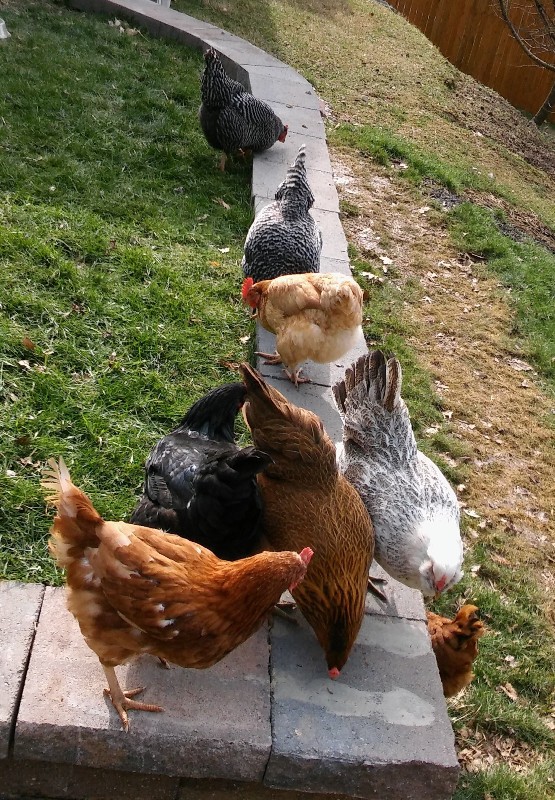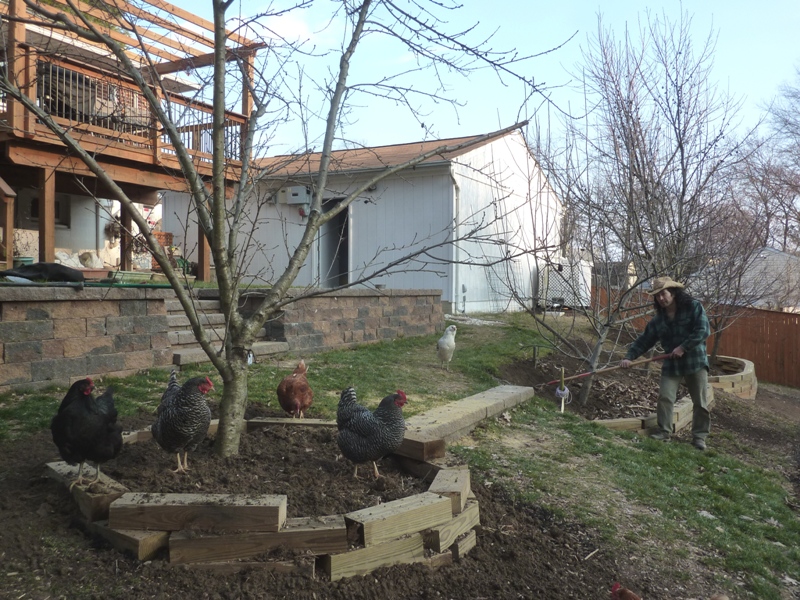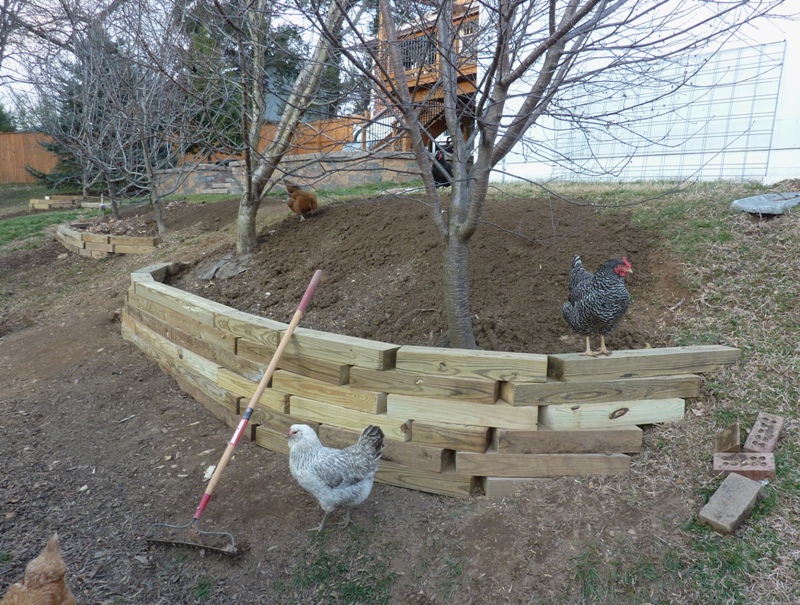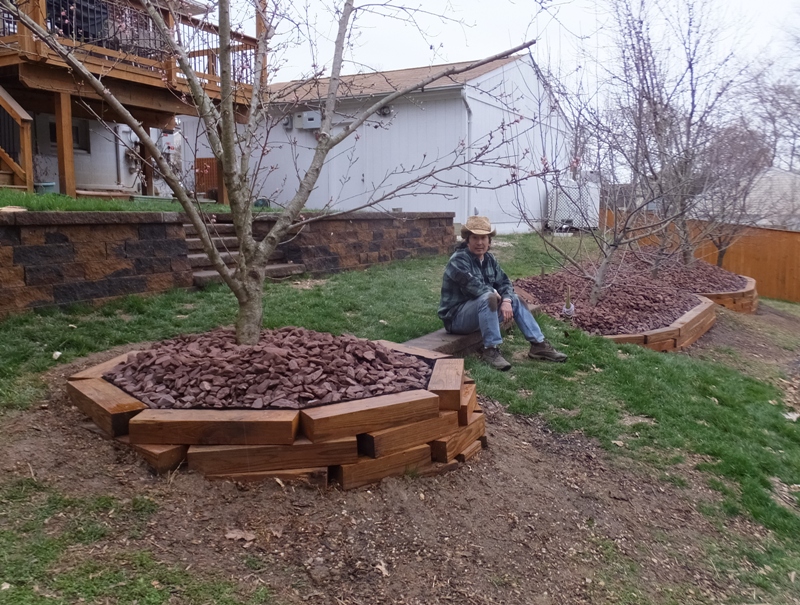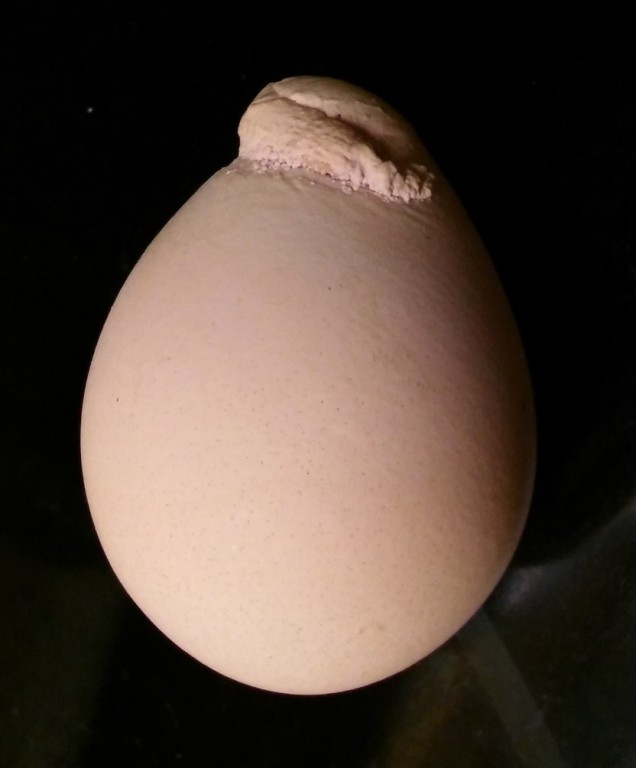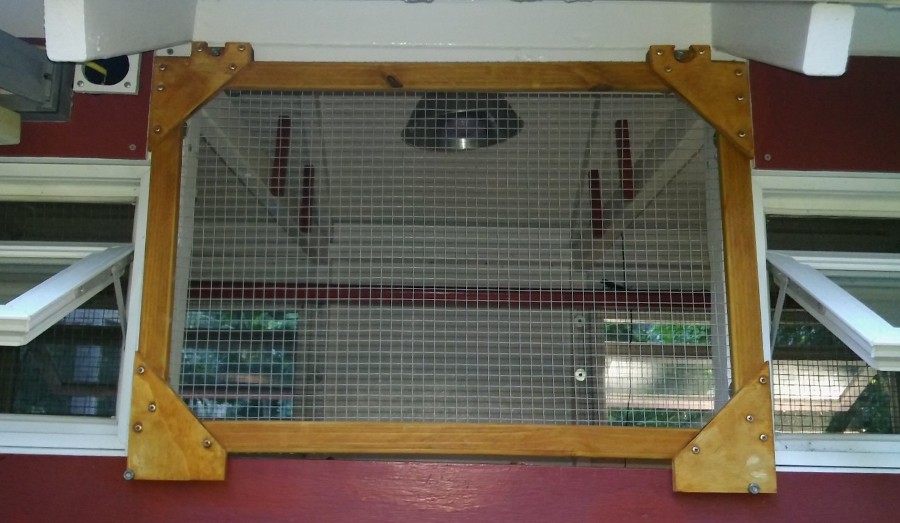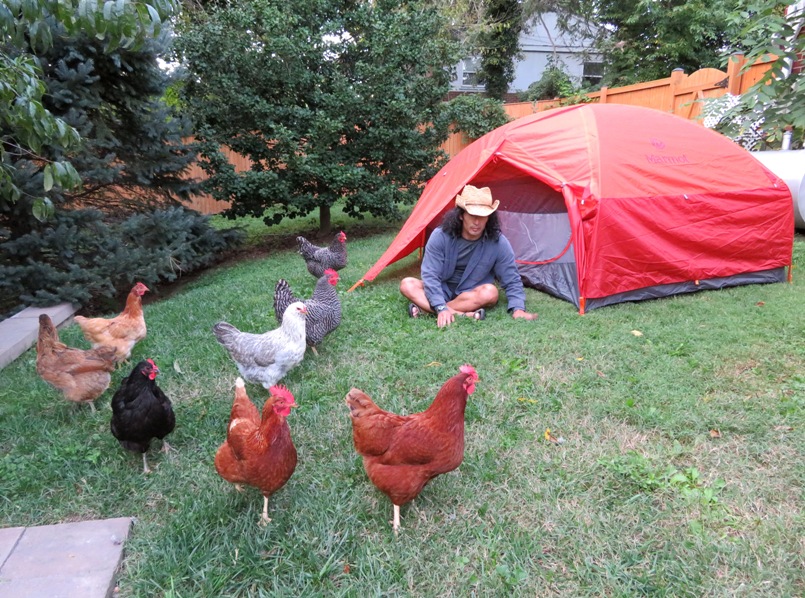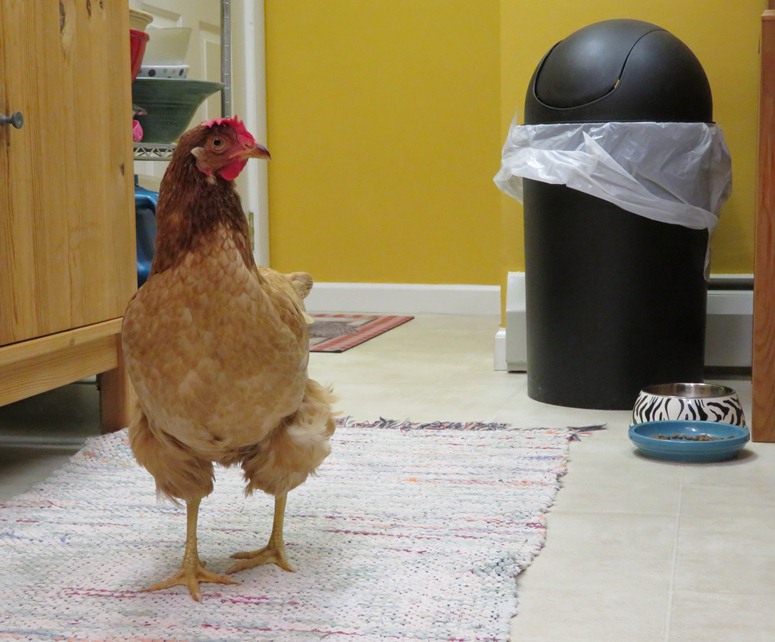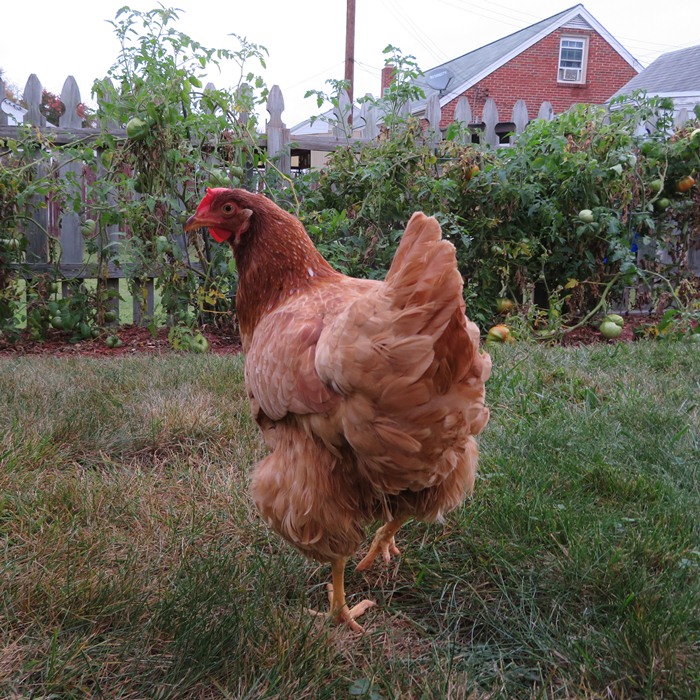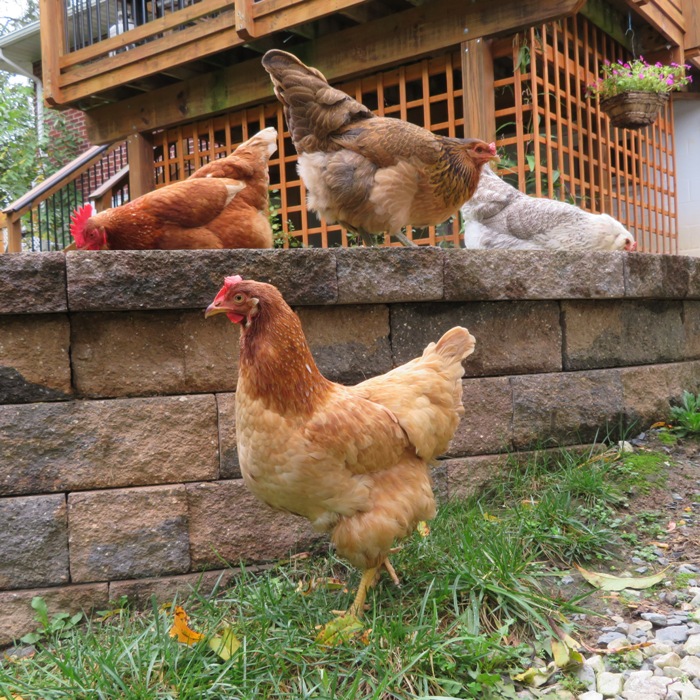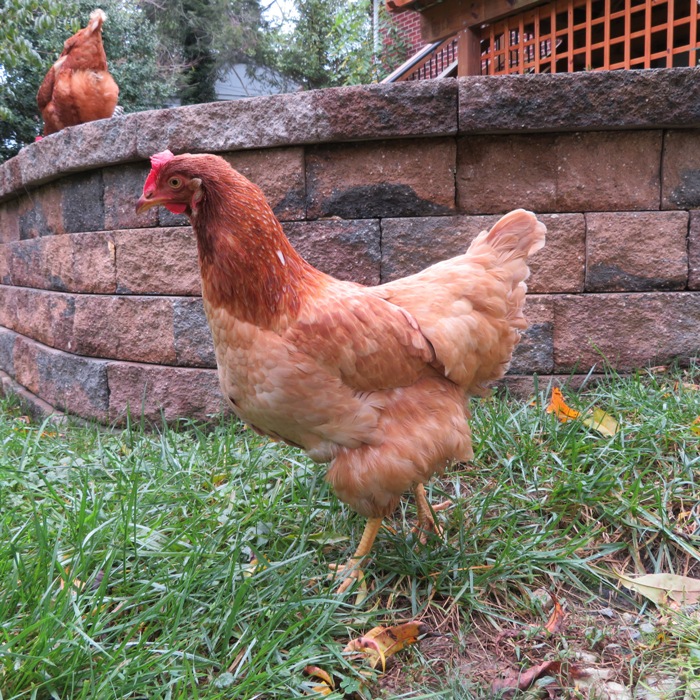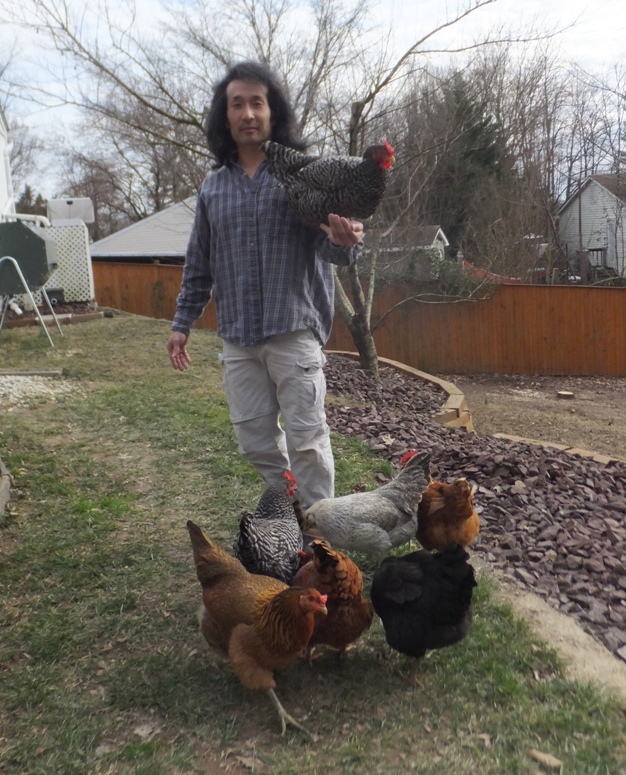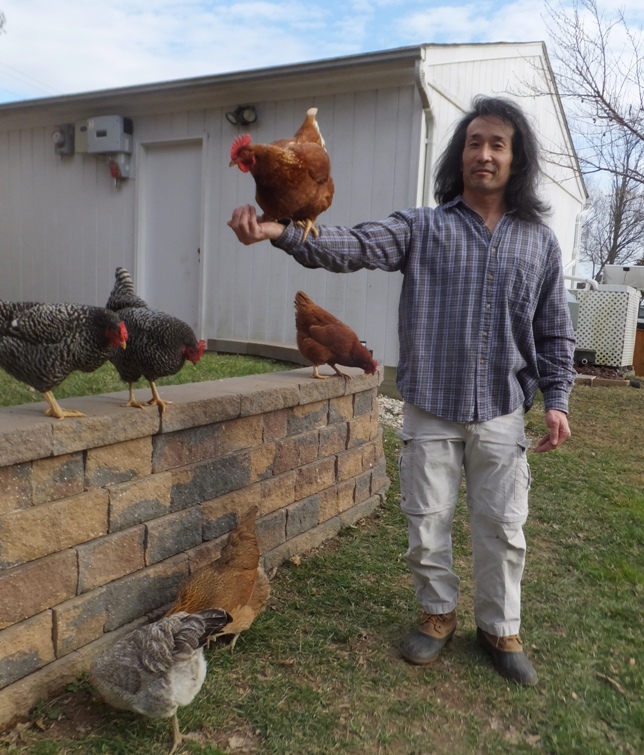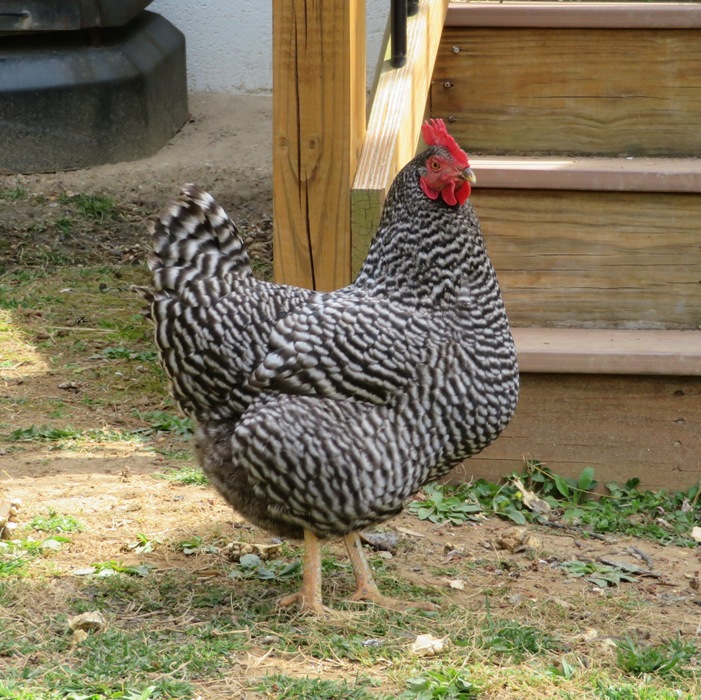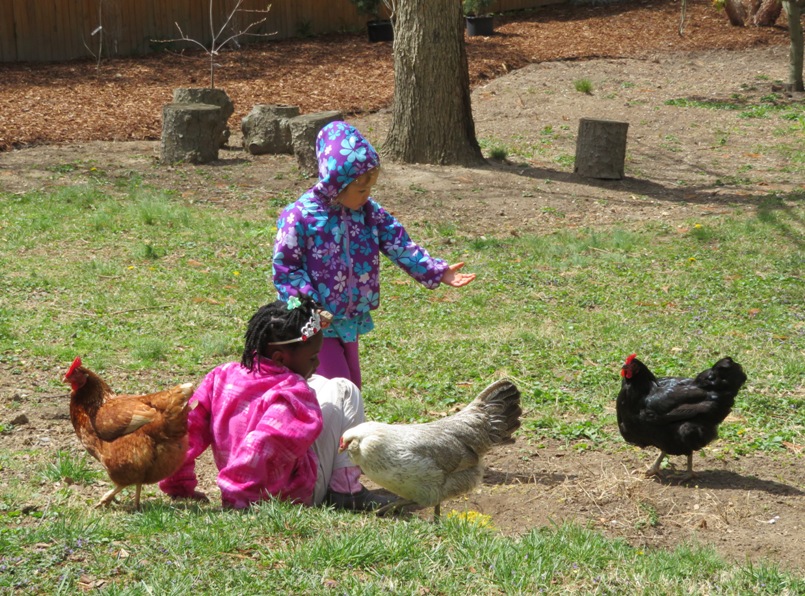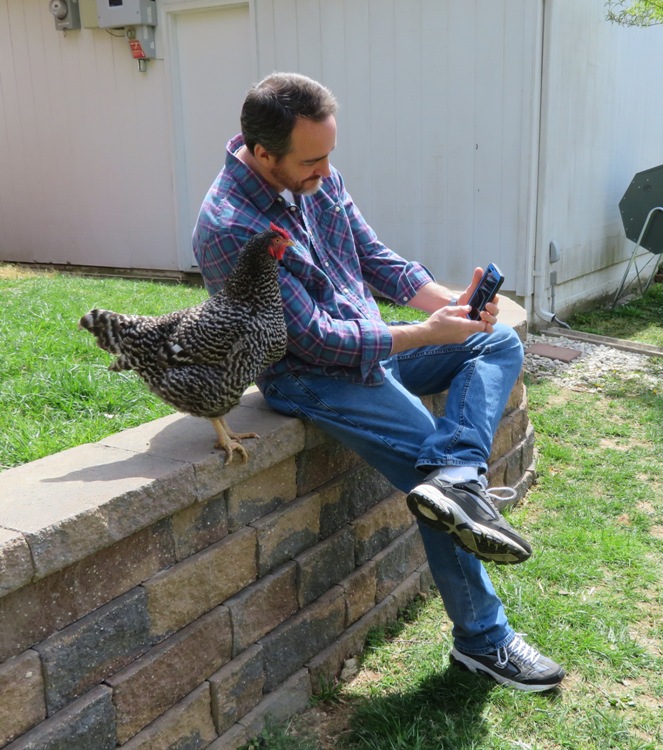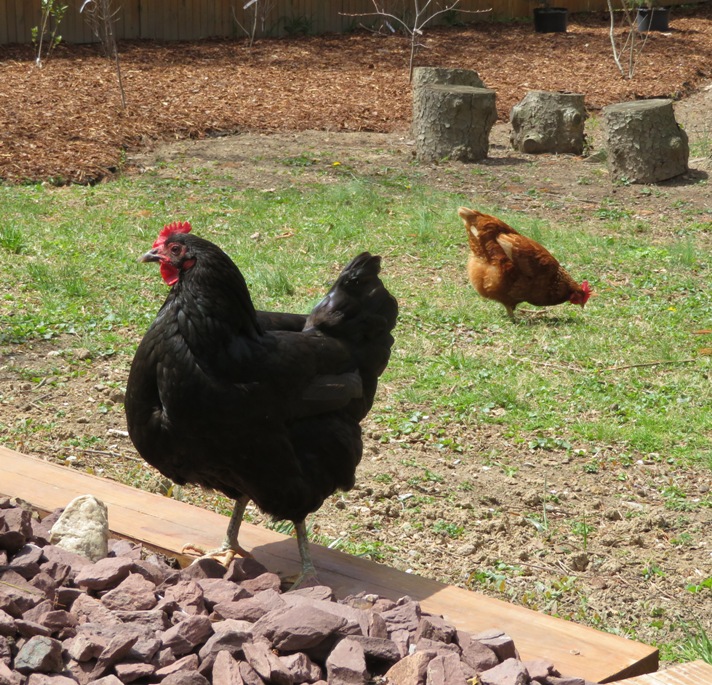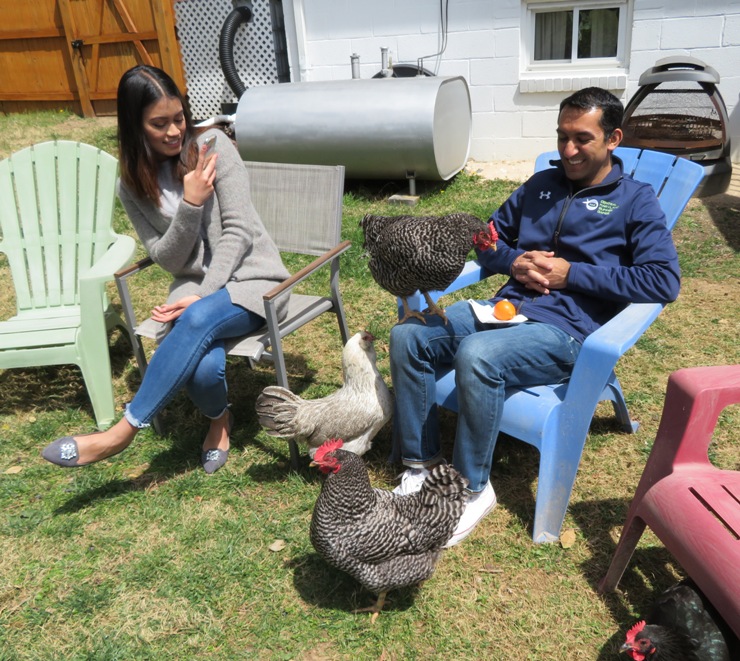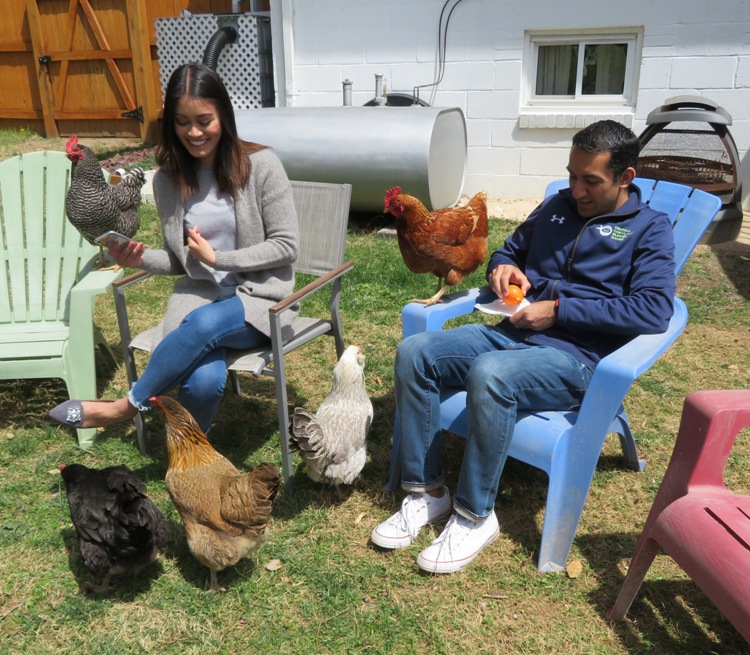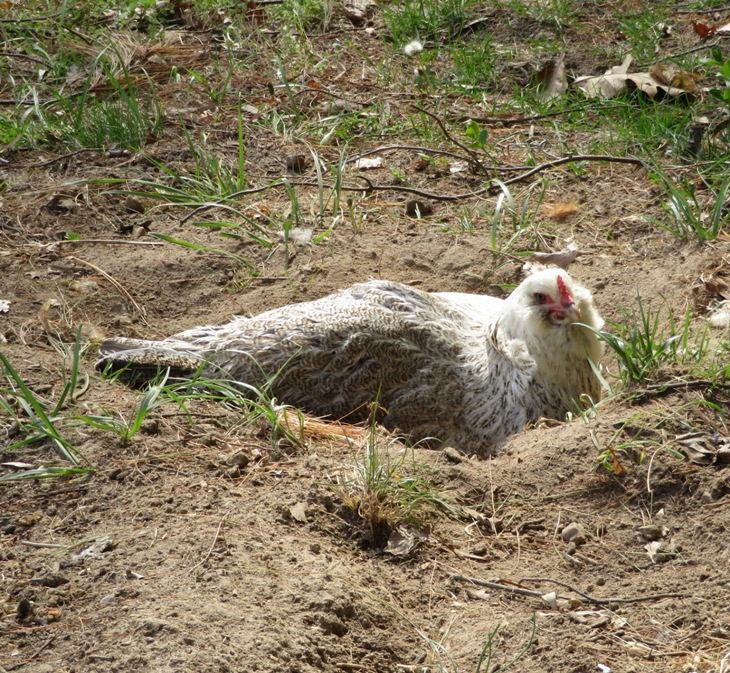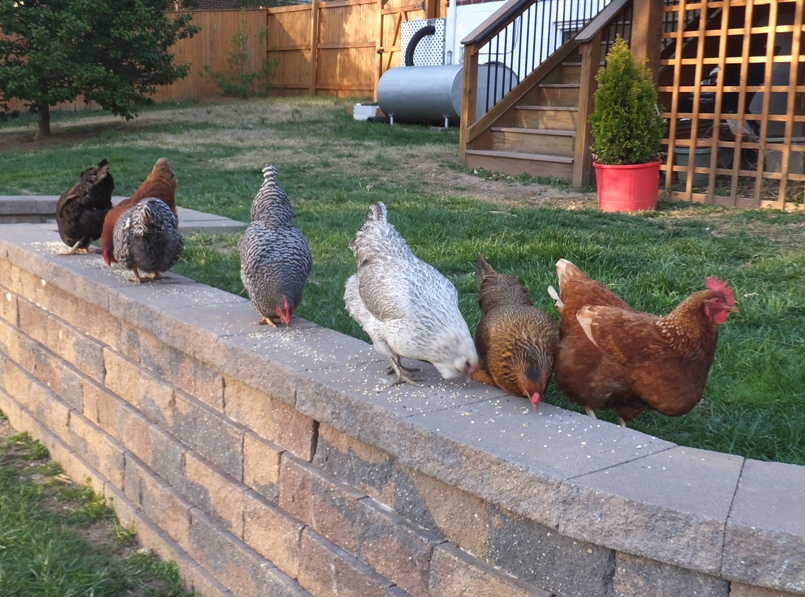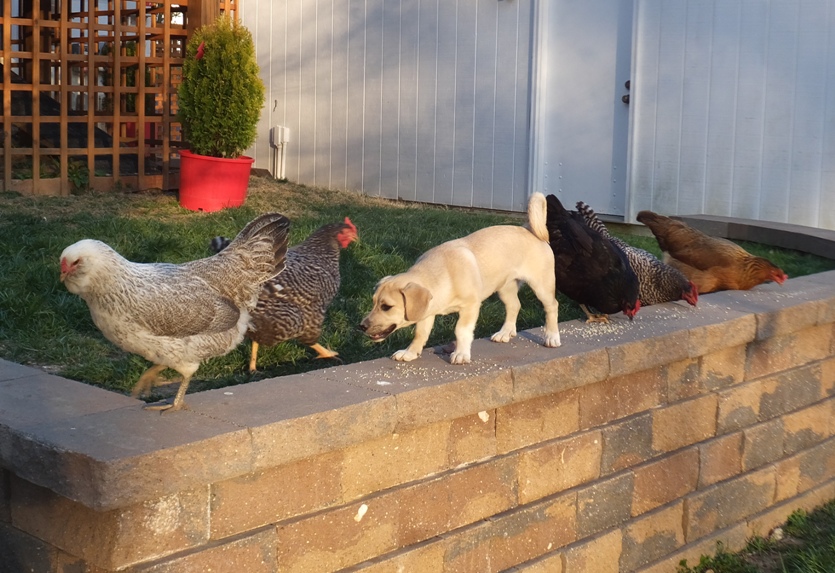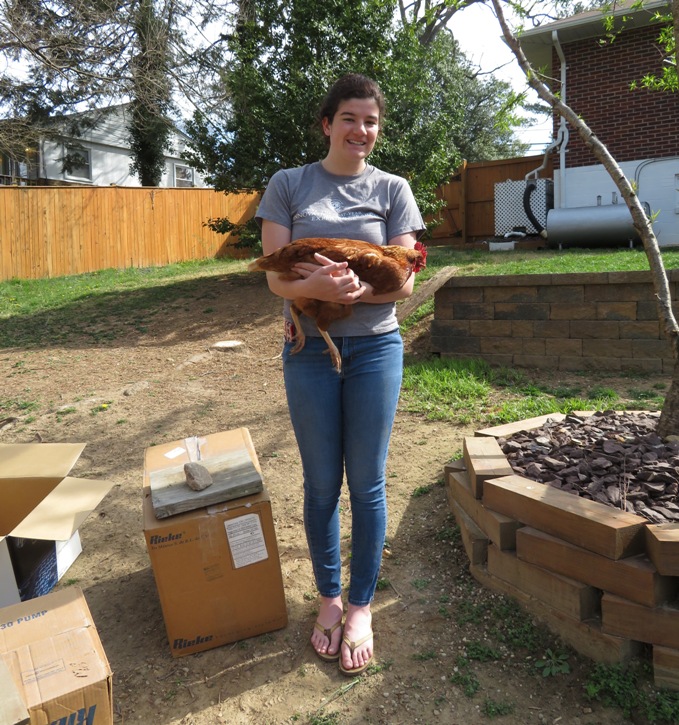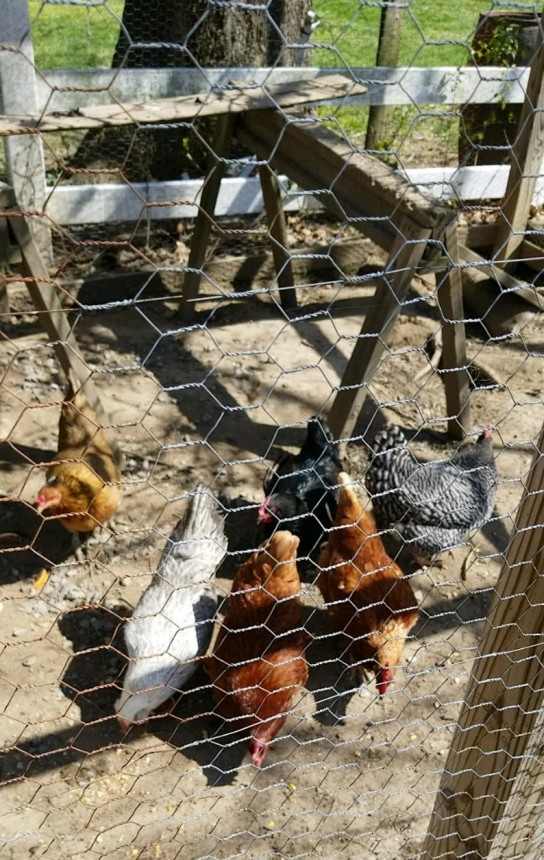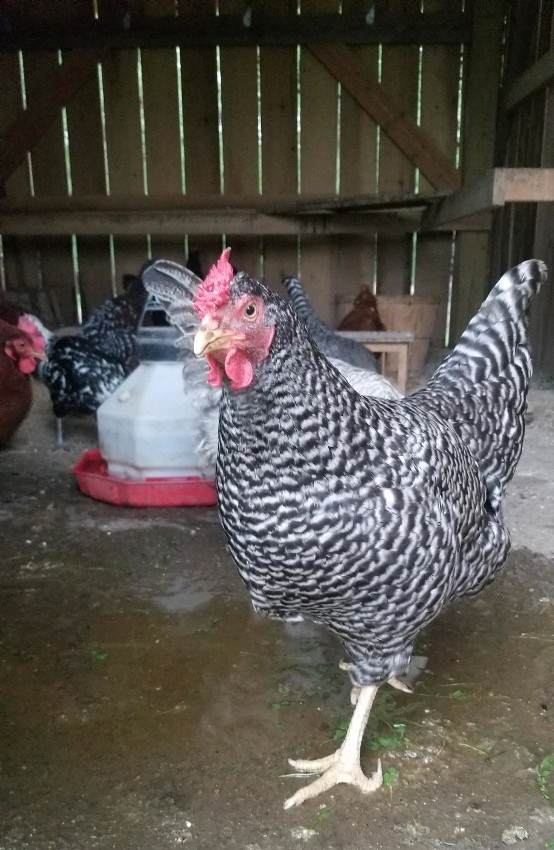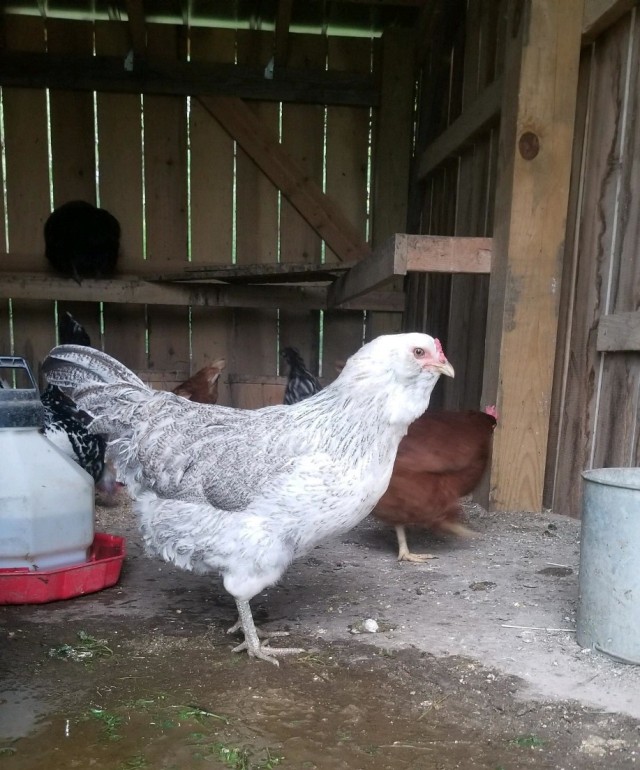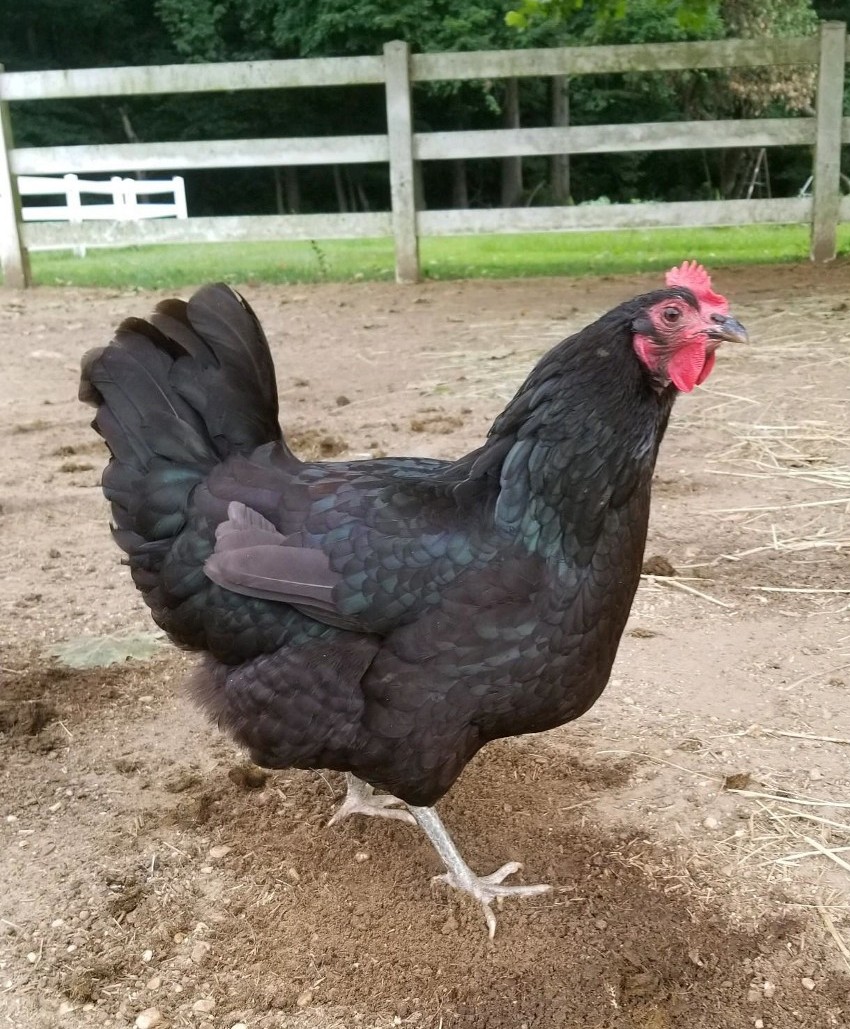Pastry and pasty
On the morning of April 11, 2014, I removed the newspaper I had placed on top of the pine shavings so the chicks could frolic about on the bare pine shavings. This made for a cleaner environment. But that also meant that the chicks were scratching and putting a lot of pine shavings into their fount. I ended up having to clean that out three times a day.
I bought pastries to share with my co-workers. I sent out an e-mail announcing the arrival of the chicks. It was truly a cause for celebration. I also brought in a list of the different breeds I ordered and the Meyer Hatchery catalog that shows what the breeds look like as chicks and as adults. After one of my co-workers noticed that the hatchery is located in Ohio, he commented, "I thought the only place one could order chicks from a catalog were in Russia."
Pasting up became an issue. That is when their poop sticks to their feathers and seals off their anus. If left untreated, it could be fatal. I took some warm water in a paper towel and blotted it for awhile before trying to remove it. I wasn't having much success so I turned warm water on a slow trickle and directed a few drops of water directly onto the caked up poop to soften it up before removing it. It took quite awhile and the
buff orpingtons weren't too willing to cooperate. Unfortunately, they seemed to be the ones that were more prone to pasting up. Maybe it is because they are supposed to get bigger than a lot of the others so they are eating more.
It's mostly a problem during the first week, and that chicks that paste up once are likely to paste up again [56].
Coop-to-Coop Tour
On April 12, 2014, I was ready for the
Howard County Conservancy Coop-to-Coop Tour. This was scheduled to run from 1000 to 1400. During this time, we had about 16 visitors. I got a lot of compliments on my coop. Most of the visitors did not have chickens but were very curious. A few already had some and wanted to see what others had done. I really enjoyed talking to people, especially the veteran chickens owners. I learned a few things.
Guinea hens make a good early warning system for the other chickens. They can be annoying but if they see a raptor, they let out a cry that alerts the others and gives them time to run for cover. The Guineas are pretty small and agile and can usually hide pretty quickly.
The EcoGlow 20 Chick Brooder doesn't need to provide 95 degrees of heat because it is a different type of heat than a heat lamp. It provides enough to keep the chicks happy and grow to adulthood.
Nothing fancy
The chicks are definitely more comfortable around me after having seen me so much.
I don't know much much they are drinking because I clean and change their water about three times a day. It almost seems like they are trying to kick pine shavings into the fount. Regarding food, they seem to be eating about half a mason jar of food per day. I know there are all kinds of chick and chickens treats and supplements out there but I am just using the starter feed from Southern States. It is nothing fancy but I think it is sufficient and the chicks really seem to like it. The folks that work at and shop and Southern States seem to be farmer types and not into all the frilly, fancy, newfangled stuff. So I'm guessing what they recommend will be sufficient, though not necessarily the latest thing to hit the market.
Heat lamp and EcoGlow20
The photos Norma and I took earlier with the heat lamp on didn't turn out so good. The red light from the lamp distorts the colors. I took some snapshots without the heat lamp on. Here they are.
1 / 2

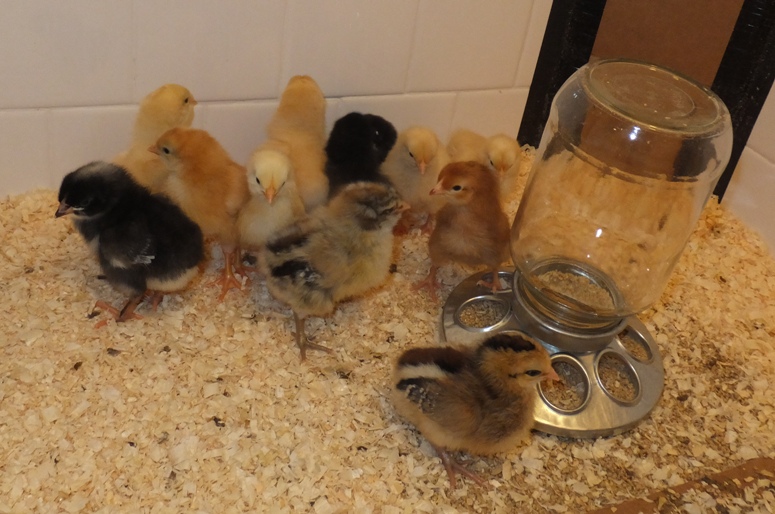
Chicks on April 12, 2014.
2 / 2

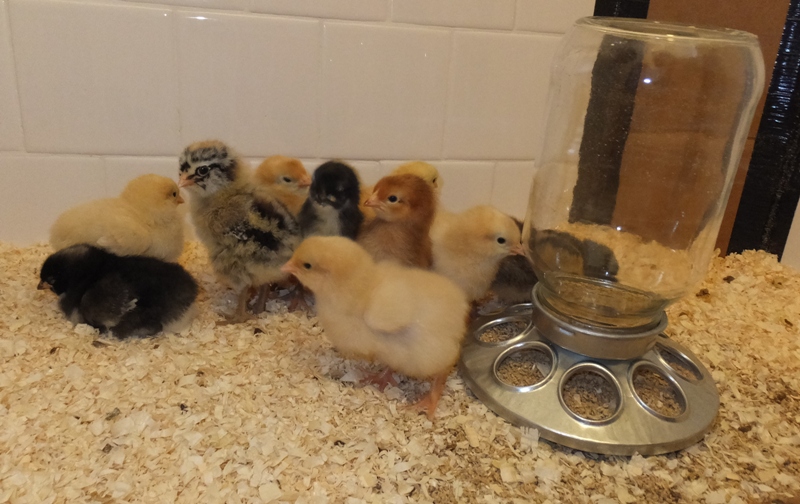
Chicks on April 12, 2014.
❮
❯
I gave the EcoGlow20 another chance. I turned it on, stuck it in the brooder, and turned off the heat lamp. I periodically checked on the girls to see how they were doing. I am getting pretty good at recognizing if they are happy or not. The temperature under the EcoGlow20 was about 75 degrees and they were all huddled underneathe, keeping warm. They weren't complaining, but they weren't active either. I was reminded of my time in Saudi Arabia and Kuwait during the first Gulf War. It was winter. Despite the fact that it was the desert, it was cold and rainy. We all huddled together in the back of the Humvee trying to stay warm and dry. We were o.k. but not exactly happy.
After about an hour, I turned off the EcoGlow20 and turned the heat lamp back on. Then they were spread out more, eating, drinking, and moving about. I think for now, I'll use the heat lamp and maybe switch to the EcoGlow20 when it is warmer or when they don't need as much warmth. I want them to eat and drink a lot so they can grow. Sitting huddled together might be good enough for them to stay alive and healthy but I think we can do better.
Real feathers
On April 13, 2014, I noticed that the chicks were growing real feathers, not just fluff, at the tips of their wings. They were noticeably larger too, though they maintained their infantile shape.
I thought they were getting used to being around people. That is true, but being handled is a totally different story. At this point, I don't care to handle them any more than necessary. They still get spooked. But they are fine as long as people don't make sudden moves, aren't loud, and maintain a safe distance.
It is fun watching them fall asleep. Their eyes slowly close. Then their head drops. Sometimes their beak plants down into the pine shavings. But they tend to walk all over each other so they often don't sleep for long before one of their peers wakes them up. Sometimes they sleep with their legs sprawled out behind. Other times, they use a neighbor as a pillow. I guess that's a little easier to do when your neighbor has real feathers.
Appetite increasing
On April 14, 2014, I cleared a few vents of chicks that were pasting up. It wasn't nearly as bad as before. It still seems the Buff Orpingtons are more prone to it than the others.
They were going through about a half jar of feed a day but now it is about a full jar.
Some of the chicks are starting to fly for a short distance. They jump and flap their wings and cover a pretty good distance. I know it isn't really flying but it isn't just jumping either. All that physical activity and growth is causing their appetite to increase.
Lettuce and cardboard
On April 16, 2014, I added about an inch and a half of pine shavings. I swept out the bathroom, wiped the floor, and took out the trash.
Norma has been giving the girls little bits of lettuce. It is hard to tell if they are really eating it. I think they prefer to fight over it and steal it from one another because the next day, I always find dried up pieces. Today she tried giving them little pieces of strawberry. We heard that chickens like red things. But they had no interest in the strawberry.
What they did find interest in was cardboard. I put a small square of cardboard under their fount to give a more solid base. I don't mind so much if the feeder gets knocked over but I really don't want the fount to tip. Today I changed the cardboard. Before I could put the fount on, they were fighting to stand on the cardboard and peck at it. Perhaps they are like my niece and just like to make noise. Give her a pot and spoon to bang together and she's happy.
Here is what they are looking like after about a week. Notice that some real feathers are starting to grow.
Toys
On April 18, 2014, I brought home some ping pong balls for them to play with. I figured the balls are so weightless that they could kick them around, peck at them, and have some fun. But they had no interest in them.
On April 19, 2014, I tried to play with the chicks like I play with our cat. I put out some string and slowly pulled it. It caught their attention. The yellow and black chicks attacked the end of the string and pecked at it as if it was a worm. The other chicks were a little hesitant to get close.
Flying
The chicks are getting really big. I think I am going to increase their brooder space very soon. They looked much too cramped in 5.55 square feet. A girl's got to spread her wings.
On April 20, 2014, I was refilling their feed jar. When I returned to the brooder, I saw one of the black chicks on top of the 18" brooder wall. Who says chicks can't fly? I have maybe 3-4 inches of litter in the brooder so effectively, the wall is only about 14" tall. I was very impressed that she was able to fly to the top of the wall and perch there. Once there, I don't think she knew what to do. I put her back then started working on making a taller wall...just a temporary solution.
Increasing real estate
On April 21, 2014, I more than doubled the size of the brooder, making it a total of 11.38 square feet. If the brooder was 12 square feet, then in theory, it would be good until they are eight weeks old.
The new brooder makes use of the old space in the shower plus the space just outside the shower. In between is a raised divide. I filled the shower with enough pine shavings so it was almost level with the divide. Then I built a ramp so they could get down the divide. But they didn't like that. It wasn't steep but it was slick. So I made stairs. They didn't much care for that either. One and a half inch steps may not seem very high but when you're only five inches tall and don't have any arms, I suppose it is. In the end, I just added a lot more pine shavings so the space on the other side of the divide was level with the space in the shower.
After pine shavings settled and they did some scratching, the divide was still a little higher than either side. It is rather slick. I didn't want anyone to lose their footing so I covered it with hockey tape which is grippy.
The chicks weren't so eager to investigate the new side of the brooder at first. As I might have expected, it was the yellow and black chicks that were the first to investigate.
The walls of the old brooder were the shower on three sides and corrugated plastic on the fourth side that was 18 inches high. For the expanded brooder, it still makes use of the shower walls and the wall outside of the shower. There is a single cardboard wall and it is 3.5 feet high. The top 1.5 feet fold down so I can reach in and change their water and food.
One problem I've had is that their fount keeps getting filled up with pine shavings. I figured if it was just a little higher, then this wouldn't be such an issue. So I made a little table out of scrap wood to rest it on. It raised it about an inch on one side which isn't much now that they are so much bigger. On the other side, they can step up onto the table to drink. It has been working very well.
The girls have been making good use of their additional space to sprint back and forth and fly. I laughed when one of the yellow birds flew right into the fount. She looked a little dazed.
I'm still playing with them using the string. The yellow and black chicks are still the ones most interested in it. Now that they have extra room, they will grab one end of the string and then run to the other side of the brooder to get away of the others that are also interested in it.
Veggies
On April 22, 2014, I bought more feed. They finished off their 25 pound bag.
I also bought some celery at the grocery store. I gave them some of the leaves after I tore them up. I made sure not to give them any stem-like parts...just the more easily digestible leafy parts. They really loved it. I put a stack of the leaves on the table I made for them. One of the yellow or black birds grabbed the first leaf and started running with it. Then the other birds chased it and tried to take away the leaf. But there was still a whole stack of leaves at the table. That was fine since it gave some of the less aggressive birds a chance.
Pasting up no longer seems to be an issue.
The
Rhode Island Red (Rosemary) is not as active as the others. She doesn't seem as hungry and doesn't run around as much.
On April 24, 2014, I added more pine shavings. Norma fed them some spinach. I make sure she just gives them the leafy parts (not the stems), washes it off, and breaks it up into small pieces.
Finger perch
I took some photos of them now that they are two weeks and a day old. They are not as afraid of the camera as they used to be but they still panic when I add more pine shavings. In the below picture, you can see their fount mounted on their table.
Today was a huge breakthrough in terms of socializing. I put my hand out and one of them put a foot on my finger. I slowly raised my hand up and then she put her other foot on my finger. She was perched on my hand! She stayed there for quite a long time, even when I raised my hand up.
I couldn't get any of the other chicks to do that. The fact that this one perched on my finger before Norma's is like a baby saying "Daddy" before saying "Mommy."
Playtime
Rosemary is still often the one that is sitting when the others are moving about. It would be good of I could motivate her to get a little exercise. I checked her vent. All clear. She looks normal. She will be one of the bigger birds so I am wondering if her calories are being used more for growing than being active.
On April 28, 2014, I bought a couple of small bells. I suspended them from an arm I made with a bent-up wire coat hanger. I know chickens often like to peck at shiny things. Not only is a bell shiny but it moves around and makes noise when they peck it. I was certain it would be a big hit and encourage them to play. I was wrong. They had no interest in it.
I've been playing with them regularly using the string. They really like to attack it. The small black bird and the larger brown
Easter Egger are the most aggressive. They grab that string and run around quite a bit. A few of them shake their head real hard like a Rat Terrier with a mouse. Their head becomes a big blur when they do this. But Rosemary has no interest in such activities.
I had the cardboard wall of the brooder folded down so it was only about 20 inches high while I changed their water and feed. The big brown Easter Egger flew to the top of the wall and perched there.
It is still just that one bird that is willing to perch for more than a few seconds on my hand though I was successful in getting the big brown Easter Egger to perch briefly. The others hate to be picked up but they will approach my hand freely. Maybe if I play with them more, they will be more open to being handled.
The girls hate the sound of my fingers rubbing on duct tape. It either freaks them out or they all get totally silent and freeze up. Clearly, they don't like it.
Gatorade for Rosemary
On April 29, 2014, Norma expressed concern over Rosemary. She fed her sugar water from an eyedropper, much to Rosemary's objections.
The next day, I added fresh pine shavings and swapped out their feed and water jars with clean ones. I do that weekly. I am in the habit of refilling their feed and fount at least twice a day now. They are eating about 1.75 jars of feed a day though I don't know how much of that feed just ends up in the pine shavings.
They got a lot of celery leaves that day, which they love.
I played with the chicks for awhile using the string. I am doing that now daily. It really works up their appetite. I threw the string to Rosemary quite a bit. She got involved but wasn't as interested as the other chicks. Still, she got the string twice. She doesn't make any noise unless she is picked up. Then she complains a lot.
Norma gave Rosemary some Gatorade and water. Rosemary did not like being force fed but it was for her own good.
Osprey
Here is what they look like after three weeks. Notice the big black and white one? We started calling her "Osprey" because she doesn't look like a chicken to us. Maybe a raptor egg got mixed up with the chicken eggs.

